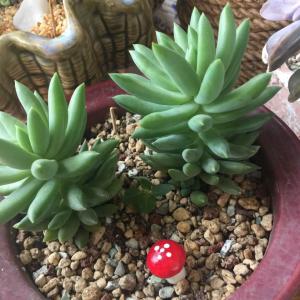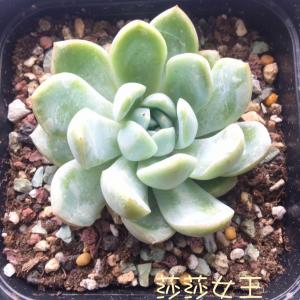lizi_mayk
2017年05月31日

It's my new garden! I bought some new, and now are growing about 19 succulents!


0
0
文章
权问薇
2017年05月29日


菊花的养殖方法
适宜的温度
因菊花种类过多的原因,所以其生长习性也不尽相同。每种植物都有最喜欢的温度,菊花也不例外,其温度在19、20度左右为宜。喜凉爽、较为耐寒,室外种的菊花耐寒抗热不易死亡,盆中养殖的菊花要格外注意严冬和酷夏。
适宜的水分
菊花对水分的需求较多,但也要合理的浇水,太多也是不好的。在多水的雨季少浇水,在少雨的旱季可以多浇一些。夏天还有开花的时候,每天浇两次水。早上一次,晚上一次。别的时候每天浇一次就好,没有特别限制,最好时间较为固定。浇水别冲坏根茎,注意这点。

适宜的光照
菊花不怕阳光,可以天天日照,但不要过多在强烈的阳光下照射,这样会让叶子、花枝减少,从而影响开花的时期。每天中午时分可以避开阳光两个小时左右,其他时候都可以让它沐浴阳光,每天十二个小时就行。
适宜的肥料
最好的方法当然是去菊花专门的商店去卖啦,不过这样成本太高也不合算。所以用些磷肥、钾肥、全素肥、有机肥就好。使用肥料是根据天气还有菊花的生长情况而制定的。普通情况下,5天一次即可。花开了就别用肥料了。使用肥料要适量太多太少都对菊花生长不利。
适宜的土壤
菊花是种适应力很强的植物,在大多数土壤中都能存活。最好的还是种在土地比较疏松肥沃、排水优良、有些烂树叶的腐物质土壤中。
0
1
文章
西派九叔
2017年05月27日


庭院花园制作
利用空木箱,只用几个月的时间就能,创造出五彩缤纷的天堂。
准备了一只木箱,在木箱上均匀的钻出19个洞,数量和间距可根据木箱大小适当调节。
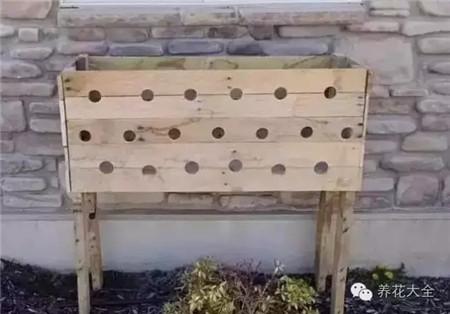
从花市买来的矮牵牛,在准备种植之前,先在木箱底部铺上一层杂草,再用湿土覆盖,保持水分。
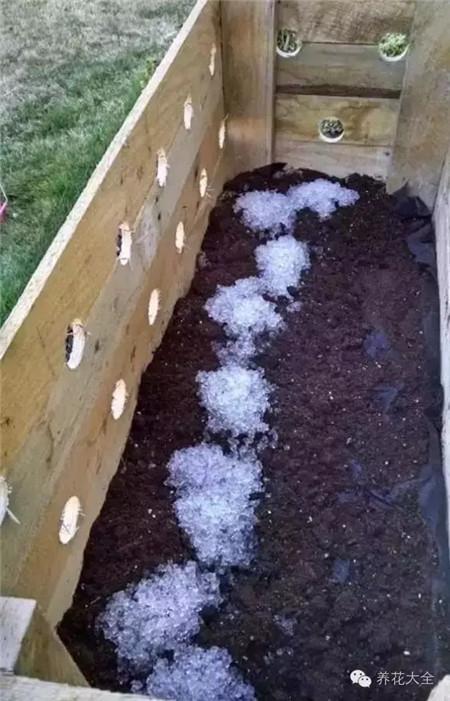
种上第一层小花苗,再铺上一层湿土。
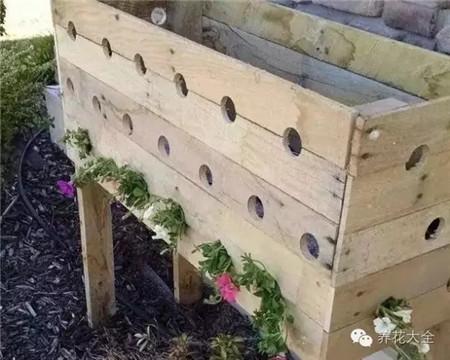
过多的剩余空间可以用填充物填满,这位达人选用的是泡沫。

按照上面的步骤,盖上第二层以及第三层,坚持每天浇水(水要浇透),一个礼拜施肥一次。
经过细心的照料,小花苗渐渐茁壮成长,越来越富有生机。
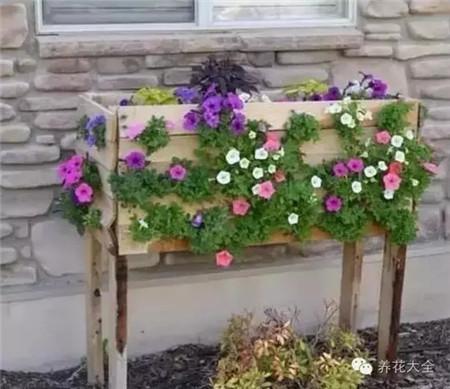
一个月后,整个箱子都要被美丽的矮牵牛给覆盖满了,花园越来越缤纷啦。

但可能由于夏天天气太热,叶子虽然还是很绿,但是花却剩下没几朵了这时,开始除虫,希望矮牵牛可以再度盛开。
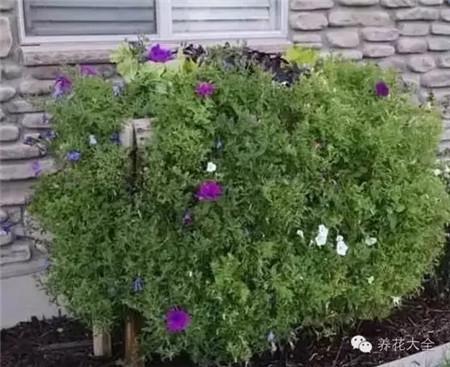
一个月过去,经过悉心照料,美丽的矮牵牛又再度盛开了,花园重回往日的茂盛,且更甚之前。
花朵全部盛开的时候可谓相当惊人,缤纷的花朵覆盖了整个木箱,就彷彿来到了鲜花殿堂,路人无不被眼前的美景吸引。

虽然建造一个花园并没有想象的那么简单,浇水、施肥、除虫等工作都马虎不得,但是只要你愿意花时间好好照料这些花草,相信拥有美丽花园的日子不远了。

原来爆盆也很容易嘛~
0
3
文章
查理
2017年05月26日

敬爱的周总理把必胜的精力都贡献给中国革命和建设事业,日理万机,鞠躬尽瘁,虽然无暇亲自莳养花草,却在紧张的革命年代里和繁忙的国事,外事活动中,留下了不少与花有关的佳话。
1946年5月初,以周总理为首的中共代表团来到南京的梅园新村,同国民党政府进行了10个月零4天的针锋相对的谈判斗争。梅园新村院内种着美丽的海棠花,在紧张的谈判间隙,周总理经常助理院中观赏海棠,稍事休息。因此,海棠一直是周总理最喜欢的花木之一。
1957年2月1日,周总理访问了位于印度洋上的魅力岛国--斯里兰卡。斯里兰卡人民八凌霄花当作和平与友谊的象征。因此,在隆重的仪式上周总理亲手栽种了一株美丽的凌霄花,架起了中,斯两国人民友谊的金桥。20年后的1977年4月,邓颖超副委员长也应邀访问了斯里兰卡,总理生前亲手种植的凌霄花已根深叶茂,邓颖超同志对他进行了培土管理,又在附近亲手栽种了一棵“花后树”。这两株象征这中斯两国人民深情厚谊的花木,将世代相传。
1954年4月,周总理到日内瓦参加一个国际会议。在他居住的的宾馆院子里,有一株树木特别引人注目。这种树的树身并不高,却缀满了白花。那盛开的朵朵白花,既像展开双翼翩然欲飞的鸽子,又如垂挂在树上而飘逸不止的白手帕。总理感到十分新奇,便询问此树何名。导游回答:”这是从贵国引进的树种,名叫鸽子树”。总理听罢更加惊奇。总理回国后,便向北京植物园的专家打听,并希望搞个水落石出。不久,他们在云南发现了这种树。从此,我国特产的珍贵树种--中国鸽子树开始进入庭院,成为世界驰名的庭院花木。
1946年5月初,以周总理为首的中共代表团来到南京的梅园新村,同国民党政府进行了10个月零4天的针锋相对的谈判斗争。梅园新村院内种着美丽的海棠花,在紧张的谈判间隙,周总理经常助理院中观赏海棠,稍事休息。因此,海棠一直是周总理最喜欢的花木之一。
1957年2月1日,周总理访问了位于印度洋上的魅力岛国--斯里兰卡。斯里兰卡人民八凌霄花当作和平与友谊的象征。因此,在隆重的仪式上周总理亲手栽种了一株美丽的凌霄花,架起了中,斯两国人民友谊的金桥。20年后的1977年4月,邓颖超副委员长也应邀访问了斯里兰卡,总理生前亲手种植的凌霄花已根深叶茂,邓颖超同志对他进行了培土管理,又在附近亲手栽种了一棵“花后树”。这两株象征这中斯两国人民深情厚谊的花木,将世代相传。
1954年4月,周总理到日内瓦参加一个国际会议。在他居住的的宾馆院子里,有一株树木特别引人注目。这种树的树身并不高,却缀满了白花。那盛开的朵朵白花,既像展开双翼翩然欲飞的鸽子,又如垂挂在树上而飘逸不止的白手帕。总理感到十分新奇,便询问此树何名。导游回答:”这是从贵国引进的树种,名叫鸽子树”。总理听罢更加惊奇。总理回国后,便向北京植物园的专家打听,并希望搞个水落石出。不久,他们在云南发现了这种树。从此,我国特产的珍贵树种--中国鸽子树开始进入庭院,成为世界驰名的庭院花木。
0
0
文章
苍山洱海
2017年05月23日

Growing plants indoors can make your home look lively and lavish and if you too love that– Must see our 19 best DIY indoor garden decoration ideas!
If you too love indoor gardening (like we do!), learn about the arrangement ideas, DIY tricks and how you can maximize your planting space available indoors in this article.
1. Use Wall Mounted Storage to Keep Pots

The space between windows can also be prime real estate for growing, just like this one in the picture above. You can use wall mounted storage to keep the pots to decorate your home with plants.
2. DIY Pegboard Planter

This DIY pegboard planter project is simple, inexpensive, and easy to follow. If you want to see the step by step tutorial, visit brePURPOSED!
3. DIY Ladder Planter/Ladder Shelf

If you have got an old ladder, use it to keep pots in it. It can be made into an astonishing pot holder, perfect for growing indoor plants. A step by step tutorial is available on our site!
4. DIY Succulent Frame or Succulent Wall Planter

A DIY succulent frame or succulent wall planter is a great way to add a whim to your interior without spending a lot of money on materials you can make this. Here is the tutorial to follow.
5. Mason Jar Ideas

Upcycle mason jars can used to grow herbs. Here are some DIY ideas.
Mason jar can become adorable small pots and can be used to grow plants and herbs indoors. There are myriads of ideas available on the web to look for inspiration, you can look at one of our posts for more ideas!
6. Indoor Chair Planter

Not only outdoors, if you’ve got an old chair create an indoor chair planter and grow succulents or indoor plants on it to add a dramatic touch to your rooms. See more chair planter ideas!
7. Indoor Zen or Japanese Garden

An indoor Japanese or Zen garden can be a beautiful addition to your home when combined with a water feature, flowers of cool colors, stones, or succulents, a great way to add “calmness” to your home. You can also make a mini succulent zen garden in a pot, check out the tutorial here.
8. Flowering Houseplants

Decorate your indoor garden with flowering houseplants. They can add a bright touch to your home, growing them is similar to other indoor plants. Check out our article on best flowering houseplants here.
9. Use Plant Stands

Plant stand can not only increase your indoor planting space but also look elegant and decorate your home. The best thing about them is that you can also DIY them easily, here are some ideas.
10. Succulent Bookend
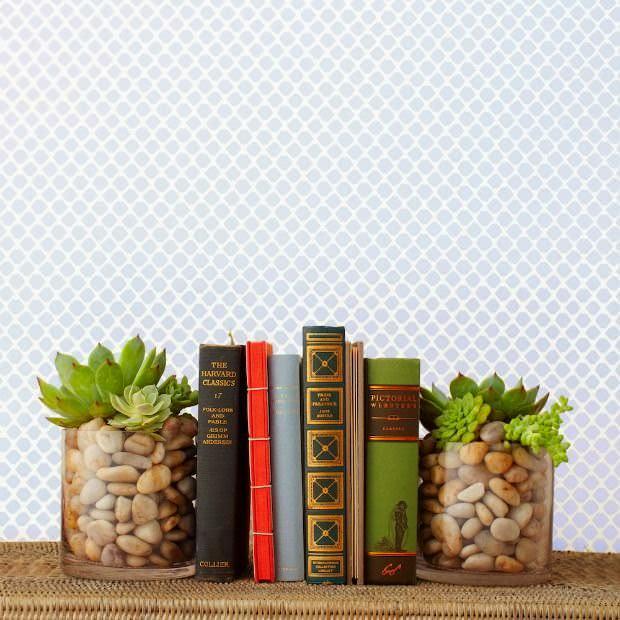
Prop up your favorite reads with this easy-to-make mini garden. Succulents are easy to grow. They add a welcome pop of greenery to any book collection when planted in clear vases filled with pretty river stones. See more of it here.
11. Hanging Coconut Planter
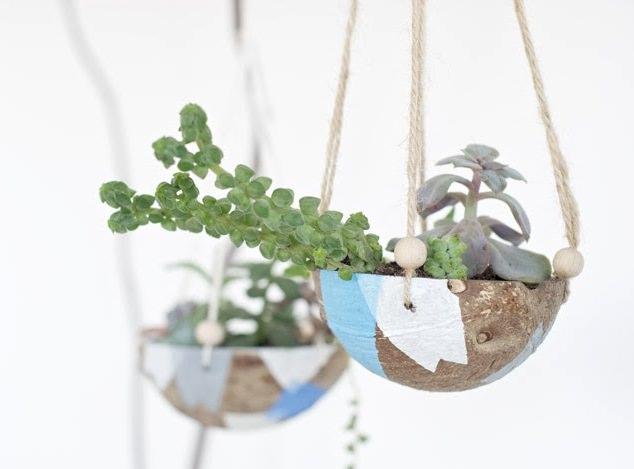
Use coconut shells after eating to create this super cute hanging indoor garden. This project is unique, still simple and doesn’t require much. Check out the tutorial here.
12. Sea Shell Planter
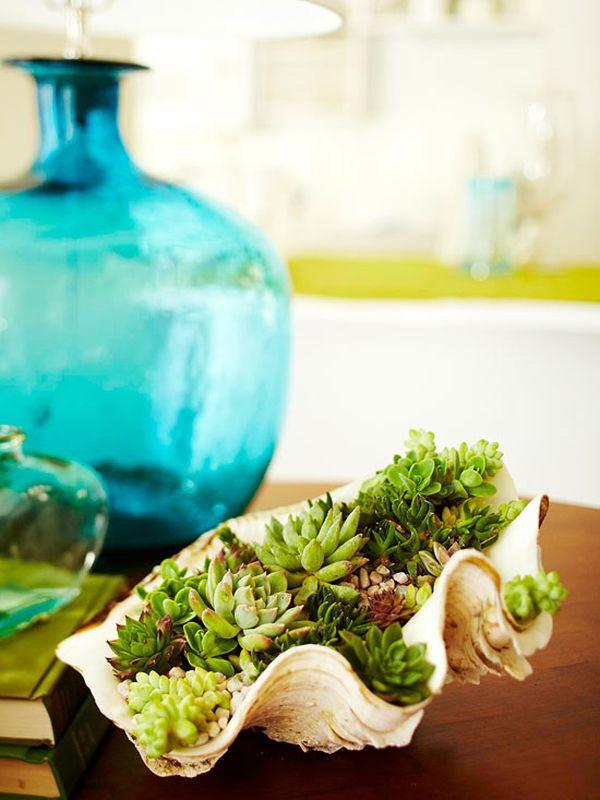
Sea-shell planters are creative ways to show off plants. You can tuck smaller succulents and use them as a centerpiece of your home. Check out these ideas!
13. Use Utility Cart to Hold Pots

Utility cart can be found in stores easily, it has many uses and one of them is this, especially if you’re short of space. Use it to hold planters.
14. Create an Indoor Fairy Garden

This well-planned fairy garden that resembles a gnome village (or many more other fairy garden ideas here) is looking amazing with colorful mushrooms, walkway, tiny houses, and banners.
15. Make a Succulent Dish Garden

Plant succulents in a dish and place it on the table top. It will make the focal point of the room. A complete DIY article on how to make a succulent dish garden is available here.
16. Plant Stand Room Dividers

Ikea plant stand (Socker series)
Plant stands can be used as room dividers, keeping cut beautiful cut flowers, herbs, and small plants. This way you’ll be able to maximize your growing space and create a division in a room too!
17. Keep a Plant Stand Near Window
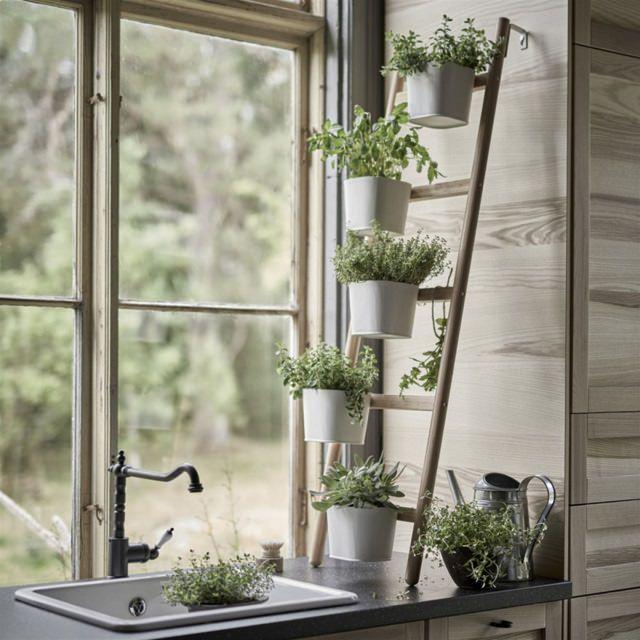
Why just keep plants on a windowsill, let the plants use the sunlight comes from the windows by keeping a plant stand like this.
18. Teacup Herb Garden

Grow a herb garden in vintage teacups that you no longer use. Not only it will look good but this way you will be able to grow your own herbs. If you want to make a teacup planter too, here is the tutorial.
Also Read: Indoor Herb Garden Ideas
19. DIY Mosaic Pots

Take some of your old clay pots and turn them into astonishing mosaic pots. It’s easy! You’ll need a terracotta pot, vase filler chips or alternatively use pot shard or broken tile pieces. You’ll also need glue and spray paint. The first step is to paint the pot in your favorite color and leave it to dry. Once done, lie the pot and glue the chips or shards one by one. See more mosaic ideas!
If you too love indoor gardening (like we do!), learn about the arrangement ideas, DIY tricks and how you can maximize your planting space available indoors in this article.
1. Use Wall Mounted Storage to Keep Pots

The space between windows can also be prime real estate for growing, just like this one in the picture above. You can use wall mounted storage to keep the pots to decorate your home with plants.
2. DIY Pegboard Planter

This DIY pegboard planter project is simple, inexpensive, and easy to follow. If you want to see the step by step tutorial, visit brePURPOSED!
3. DIY Ladder Planter/Ladder Shelf

If you have got an old ladder, use it to keep pots in it. It can be made into an astonishing pot holder, perfect for growing indoor plants. A step by step tutorial is available on our site!
4. DIY Succulent Frame or Succulent Wall Planter

A DIY succulent frame or succulent wall planter is a great way to add a whim to your interior without spending a lot of money on materials you can make this. Here is the tutorial to follow.
5. Mason Jar Ideas

Upcycle mason jars can used to grow herbs. Here are some DIY ideas.
Mason jar can become adorable small pots and can be used to grow plants and herbs indoors. There are myriads of ideas available on the web to look for inspiration, you can look at one of our posts for more ideas!
6. Indoor Chair Planter

Not only outdoors, if you’ve got an old chair create an indoor chair planter and grow succulents or indoor plants on it to add a dramatic touch to your rooms. See more chair planter ideas!
7. Indoor Zen or Japanese Garden

An indoor Japanese or Zen garden can be a beautiful addition to your home when combined with a water feature, flowers of cool colors, stones, or succulents, a great way to add “calmness” to your home. You can also make a mini succulent zen garden in a pot, check out the tutorial here.
8. Flowering Houseplants

Decorate your indoor garden with flowering houseplants. They can add a bright touch to your home, growing them is similar to other indoor plants. Check out our article on best flowering houseplants here.
9. Use Plant Stands

Plant stand can not only increase your indoor planting space but also look elegant and decorate your home. The best thing about them is that you can also DIY them easily, here are some ideas.
10. Succulent Bookend

Prop up your favorite reads with this easy-to-make mini garden. Succulents are easy to grow. They add a welcome pop of greenery to any book collection when planted in clear vases filled with pretty river stones. See more of it here.
11. Hanging Coconut Planter

Use coconut shells after eating to create this super cute hanging indoor garden. This project is unique, still simple and doesn’t require much. Check out the tutorial here.
12. Sea Shell Planter

Sea-shell planters are creative ways to show off plants. You can tuck smaller succulents and use them as a centerpiece of your home. Check out these ideas!
13. Use Utility Cart to Hold Pots

Utility cart can be found in stores easily, it has many uses and one of them is this, especially if you’re short of space. Use it to hold planters.
14. Create an Indoor Fairy Garden

This well-planned fairy garden that resembles a gnome village (or many more other fairy garden ideas here) is looking amazing with colorful mushrooms, walkway, tiny houses, and banners.
15. Make a Succulent Dish Garden

Plant succulents in a dish and place it on the table top. It will make the focal point of the room. A complete DIY article on how to make a succulent dish garden is available here.
16. Plant Stand Room Dividers

Ikea plant stand (Socker series)
Plant stands can be used as room dividers, keeping cut beautiful cut flowers, herbs, and small plants. This way you’ll be able to maximize your growing space and create a division in a room too!
17. Keep a Plant Stand Near Window

Why just keep plants on a windowsill, let the plants use the sunlight comes from the windows by keeping a plant stand like this.
18. Teacup Herb Garden

Grow a herb garden in vintage teacups that you no longer use. Not only it will look good but this way you will be able to grow your own herbs. If you want to make a teacup planter too, here is the tutorial.
Also Read: Indoor Herb Garden Ideas
19. DIY Mosaic Pots

Take some of your old clay pots and turn them into astonishing mosaic pots. It’s easy! You’ll need a terracotta pot, vase filler chips or alternatively use pot shard or broken tile pieces. You’ll also need glue and spray paint. The first step is to paint the pot in your favorite color and leave it to dry. Once done, lie the pot and glue the chips or shards one by one. See more mosaic ideas!
2
3
文章
Colorful
2017年05月23日
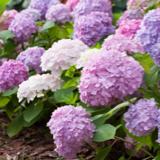
Take a look at these 19 Best low maintenance houseplants, if you’re new to growing plants indoors or find yourself lazy.
There are plenty of good things about having plants in the house. For starters, they clean up the air and smell wonderful. Secondly, they add a much-needed dash of color and accentuate the appeal of your interior.
1. Snake Plant
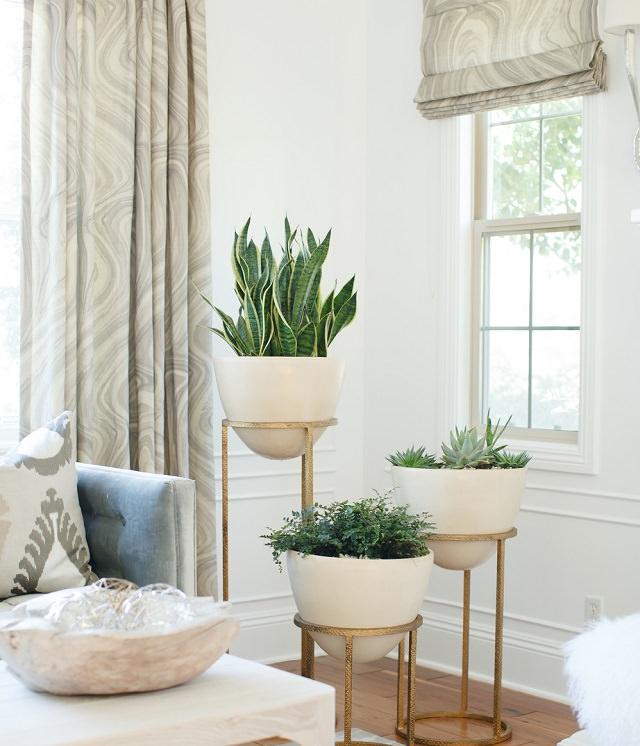
The snake plant is a low-maintenance succulent plant that thrives on neglect pretty well. If you have had little success with indoor gardening , do give the snake plant a try. All types of snake plant tolerate low light and prefer being potbound. The fact that it has thick and waxy leaves means it can withstand scarcity of water for prolonged periods of time. To put it simply, the snake plant is apt for lazy gardeners and two-week vacationers.
2. Tillandsia (Air Plants)
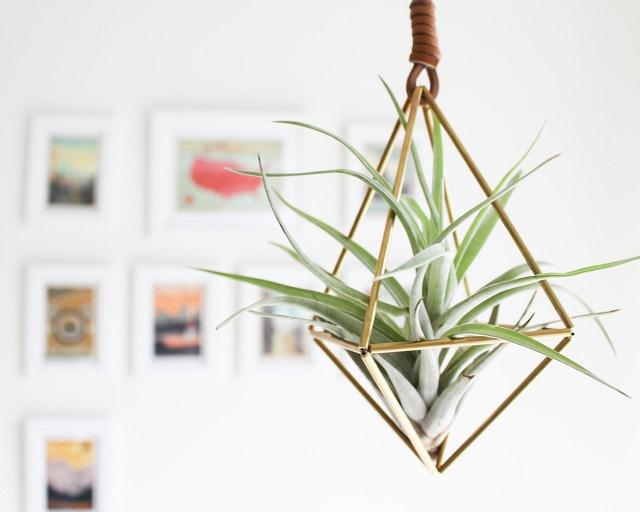
Tillandsia is a genus of air plants native to the deserts, forests and mountains of central and South America. Air plants are epiphyte, meaning they don’t need soil to grow. All you need is to mist or water them up once in a week. Some of the air plants also absorb dust– All this makes them interesting and low-maintenance houseplants. The air plants are a perfect choice for people who wish to add a touch of green to their home without much work.
3. Cast-Iron Plant

The cast-iron plant is true to its name- it’s literally indestructible. It can withstand extremes of conditions, including low light, low humidity, as well as a wide spectrum of temperatures. And it grows slowly, which means you don’t need to repot it often.
4. Kalanchoe

Kalanchoe is a genus of tropical succulent flowering plants, from the wide-leafed and bright ‘Flapjack’ to the compact Kalanchoe manginii or Kalanchoe blossfeldiana. Kalanchoes are easy to grow, all they ask for is a sunny spot and an occasional spritz of water. Both these varieties are architecturally interesting and last for so long with little attention from your end.
5. Philodendron
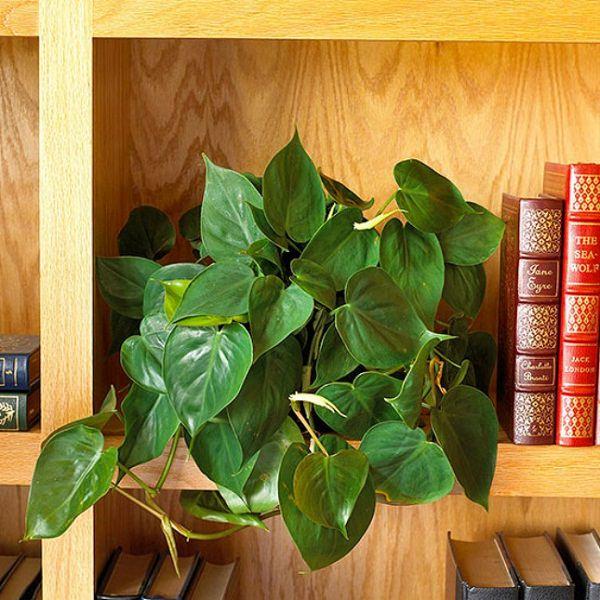
Philodendron is a fast-growing foliage houseplant with bottle-green heart-shaped leaves, similar to pothos. This plant is extremely durable and adapts well to low-light areas. Philodendron looks great in hanging baskets or when branches trailing down from above.
6. ZZ Plant
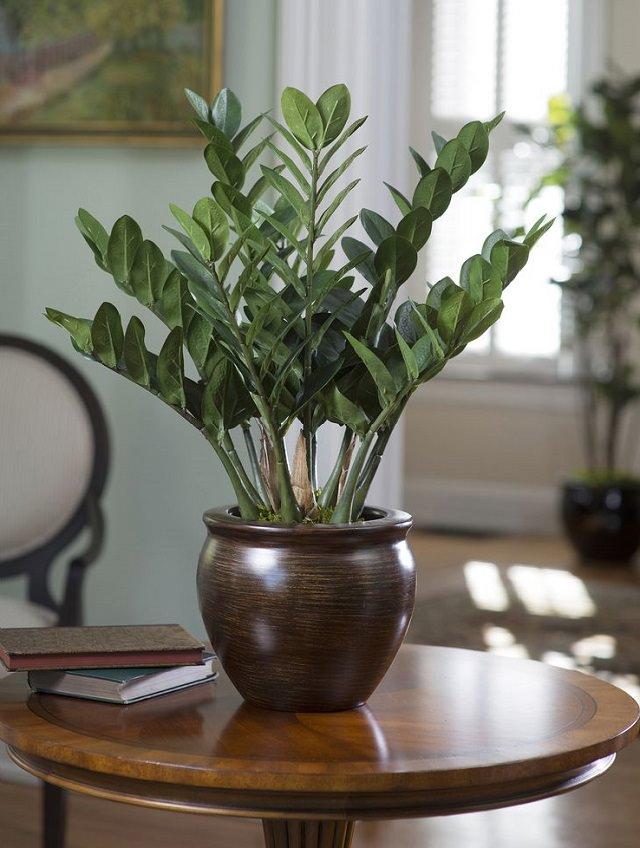
The ZZ plant is also known as the eternity plant as it lasts so long that it’s practically a challenge to kill it! Its fat succulent leaves are thick, fleshy leafstalks are so durable that they can be easily mistaken for plastic. Since the plant is a slow grower, you may want to purchase a large plant if in case you need a big specimen for your house.
7. Bromeliad
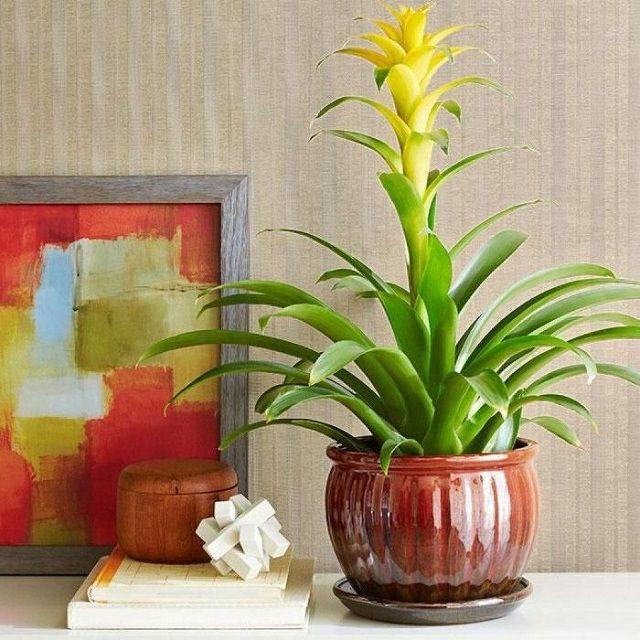
Bromeliad, like pineapple, belongs to the bromeliacea family. This plant produces a delicate pink inflorescence that is beautiful to look at. It lasts long too, and occasionally produces new side shoots that replace the original ones.
8. Jade Plant
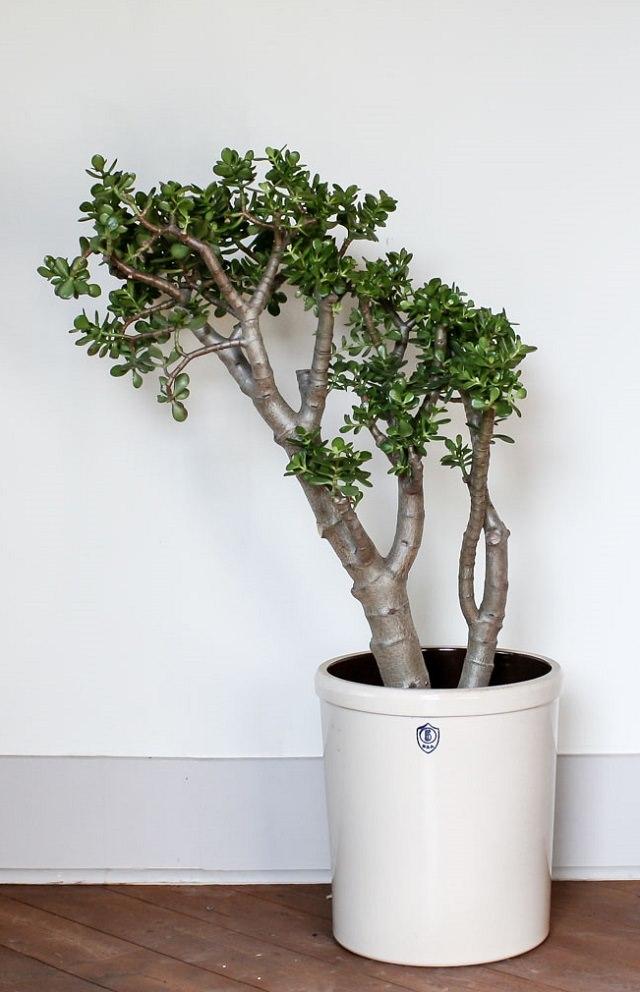
Native to South America, Jade is a low maintenance indoor plant. A succulent that retains water in its round, fleshy leaves. They thrive on neglect, so all you need to do is place them in a bright and airy spot and you’re done. As the thick trunk of jade plant easily gives it a mature look, it is also good for bonsai making.
Also Read: Best Plants and Trees for Bonsai
9. Succulents
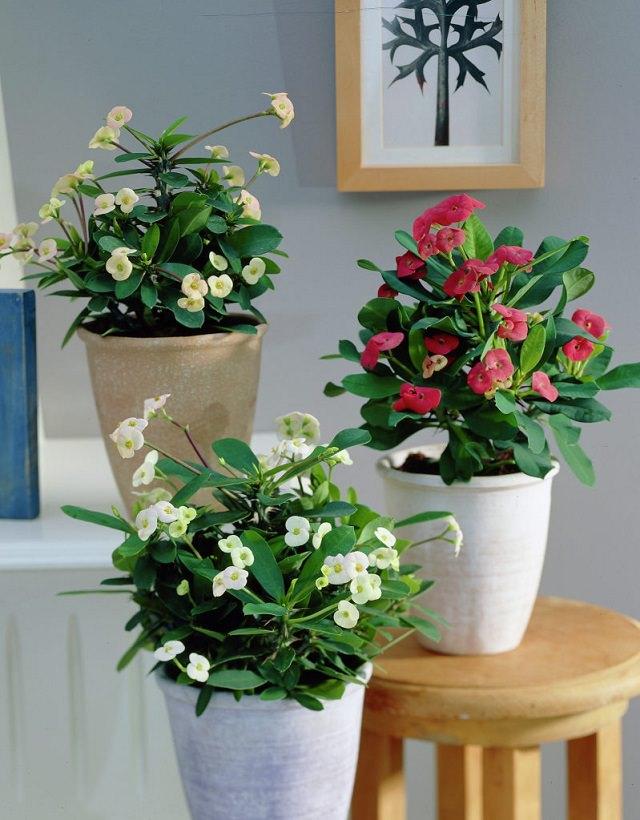
Whether its Crown of thorns or any other succulent most of them are the plants that are easy to grow indoors. Especially for those who forget to water the plants for days. If you’re interested in knowing more about the succulents that are easy to grow click here!
10. Pothos

Pothos is a fast-growing, leafy vine with striking variegated leaves that are tolerant to both irregular watering and low light conditions. The vine extends quickly, often leaving a 10-feet long, green trail over shelves or furniture. Though it’s not as drought-tolerant as many other plants in this list and demands some attention from you when it comes to watering.
11. Peace Lily

The peace lily is an easy-to-care houseplant that tolerates low light and low humidity really well and it seems like it is made for indoor conditions. Glossy, lance-shaped foliage with arched stems that surround the central flower spikes. It produces spoon-shaped blooms in summer usually but some varieties do blossom intermittently throughout the year. As an added bonus, it purifies noxious substances like formaldehyde and carbon monoxide from the air. If growing in a large pot peace lily can even go without water for a month. These plants thrive better on under-watering conditions.
12. Begonia
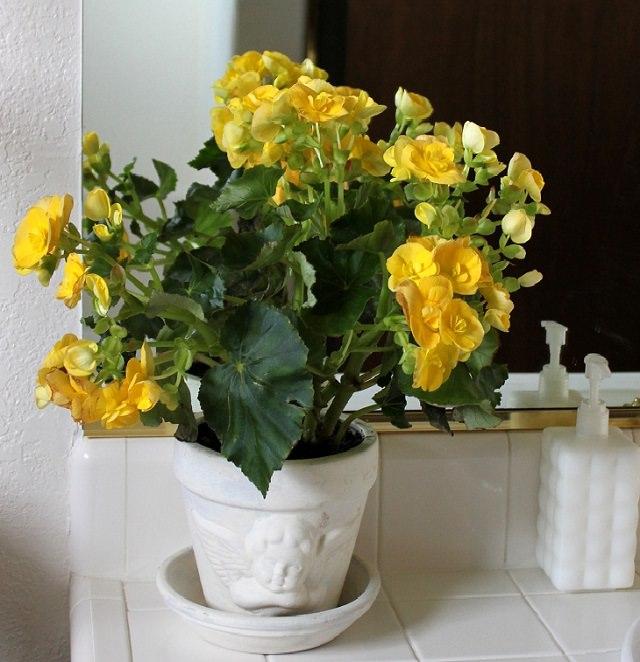
Begonias, with lush, green leaves and satiny flowers paint a pretty picture. Though they are more often thought of as outdoor plants, the fibrous and rhizomatous variants perform well indoors. They prefer humid environments, so you may want to water them 2-3 times a week in summer to make sure they stay healthy and green. They are not that fussy about light/temperature conditions. Bright, indirect sunlight works fine for them.
13. Aloe

Especially, Aloe Vera is one of the most multi-purpose houseplants in Aloe genus you can choose for indoor gardening. Its plump, spiraling leaves ooze out a soothing gel that can be used for burns and cuts. You can use it to relieve sunburns and even ingest its gel for a minty, cool feeling. Aloe loves to have some direct light and a moderate spritz of water every week or two.
Also Read: How to Care for an Aloe Plant
14. Boston Fern
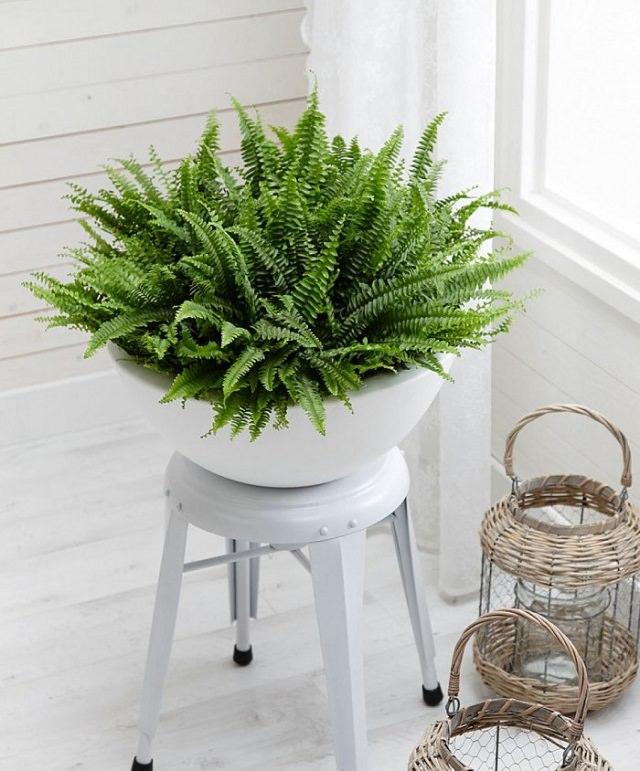
Renowned since the Victorian times, Boston fern is one of the most popular variants of fern. With its delicate, frilly leaves and lush, hanging fronds, it looks aesthetic when displayed in baskets hanging down from ceilings. Being the most drought-tolerant fern, it is easy to care for. All you have to do is to place it in a spot that gets indirect light, avoid dry air. Misting the plant in every few days also help by providing humidity.
15. Dracaena

The plants from Dracaena genus perform well as an indoor plant. They become great houseplants as they are tolerant to extreme indoor conditions. For instance, they survive well in under-watered soil. Additionally, they are not picky about light exposure. The young plants look great on tabletops, while the larger ones require sizable floor space improving the appearance of home and offices.
16. English Ivy
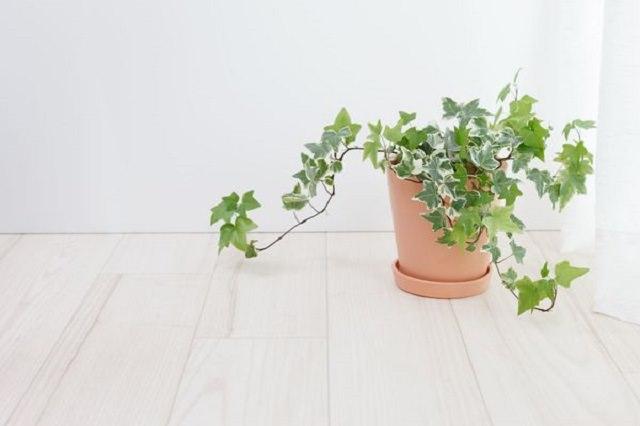
This plant is well known for its evergreen foliage. It is easy to maintain and needs as little as evenly moist soil and bright indirect light to grow well. The stems tend to grow long but can be easily controlled with pruning. For the best display, place your English ivy on a mantel where the stems can hang down luxuriantly.
17. Ponytail Palm

Contrary to its name, the ponytail palm isn’t a palm, in fact, it’s a succulent! AND; we love it. We listed it on our list of best succulents, easiest houseplants, and the best tall and large indoor plants. Don’t forget to check out these articles! It is a slow-growing plant, which means you don’t need to change the pot often. It performs best in sunny spots but never mind low lit areas receiving only bright indirect sunlight day long, also, the plant has low watering needs.
18. Spider Plant
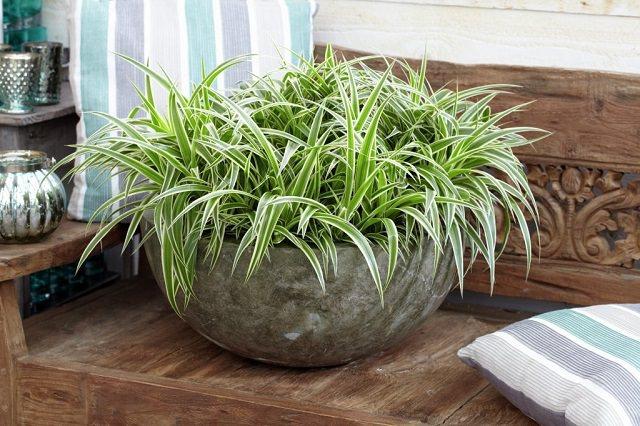
Spider plant is one of the most grown low maintenance houseplants. This forgiving plant doesn’t mind irregular watering and goes for weeks without water if grown in cool indoor conditions. Keeping the spider plant in low light conditions without direct sunlight is also possible.
Also Read: Plants that Grow without Sunlight
19. Rubber Tree Plant
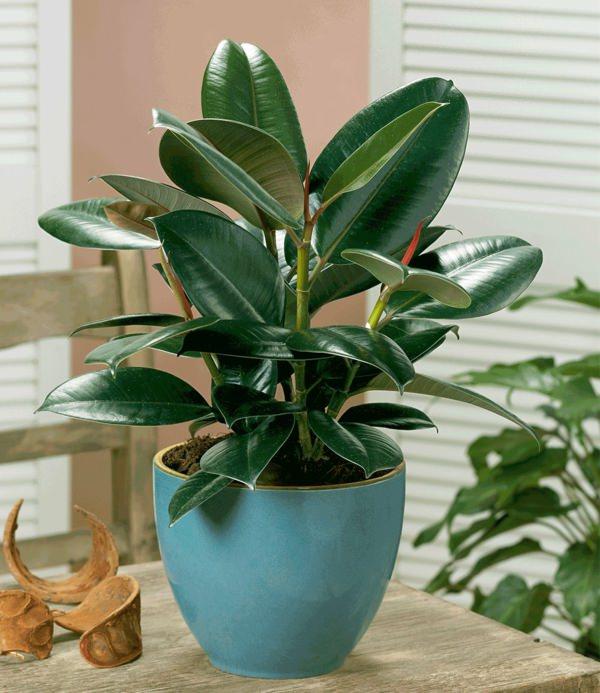
Rubber tree plant is an air purifying plant, it cleanses the formaldehyde. It is not difficult to grow and you can easily keep it in your home or office in a spot that is bright and receives a couple of hours of sunlight if possible. Avoid the exposure of the plant to the intense sun in afternoon.
There are plenty of good things about having plants in the house. For starters, they clean up the air and smell wonderful. Secondly, they add a much-needed dash of color and accentuate the appeal of your interior.
1. Snake Plant

The snake plant is a low-maintenance succulent plant that thrives on neglect pretty well. If you have had little success with indoor gardening , do give the snake plant a try. All types of snake plant tolerate low light and prefer being potbound. The fact that it has thick and waxy leaves means it can withstand scarcity of water for prolonged periods of time. To put it simply, the snake plant is apt for lazy gardeners and two-week vacationers.
2. Tillandsia (Air Plants)

Tillandsia is a genus of air plants native to the deserts, forests and mountains of central and South America. Air plants are epiphyte, meaning they don’t need soil to grow. All you need is to mist or water them up once in a week. Some of the air plants also absorb dust– All this makes them interesting and low-maintenance houseplants. The air plants are a perfect choice for people who wish to add a touch of green to their home without much work.
3. Cast-Iron Plant

The cast-iron plant is true to its name- it’s literally indestructible. It can withstand extremes of conditions, including low light, low humidity, as well as a wide spectrum of temperatures. And it grows slowly, which means you don’t need to repot it often.
4. Kalanchoe

Kalanchoe is a genus of tropical succulent flowering plants, from the wide-leafed and bright ‘Flapjack’ to the compact Kalanchoe manginii or Kalanchoe blossfeldiana. Kalanchoes are easy to grow, all they ask for is a sunny spot and an occasional spritz of water. Both these varieties are architecturally interesting and last for so long with little attention from your end.
5. Philodendron

Philodendron is a fast-growing foliage houseplant with bottle-green heart-shaped leaves, similar to pothos. This plant is extremely durable and adapts well to low-light areas. Philodendron looks great in hanging baskets or when branches trailing down from above.
6. ZZ Plant

The ZZ plant is also known as the eternity plant as it lasts so long that it’s practically a challenge to kill it! Its fat succulent leaves are thick, fleshy leafstalks are so durable that they can be easily mistaken for plastic. Since the plant is a slow grower, you may want to purchase a large plant if in case you need a big specimen for your house.
7. Bromeliad

Bromeliad, like pineapple, belongs to the bromeliacea family. This plant produces a delicate pink inflorescence that is beautiful to look at. It lasts long too, and occasionally produces new side shoots that replace the original ones.
8. Jade Plant

Native to South America, Jade is a low maintenance indoor plant. A succulent that retains water in its round, fleshy leaves. They thrive on neglect, so all you need to do is place them in a bright and airy spot and you’re done. As the thick trunk of jade plant easily gives it a mature look, it is also good for bonsai making.
Also Read: Best Plants and Trees for Bonsai
9. Succulents

Whether its Crown of thorns or any other succulent most of them are the plants that are easy to grow indoors. Especially for those who forget to water the plants for days. If you’re interested in knowing more about the succulents that are easy to grow click here!
10. Pothos

Pothos is a fast-growing, leafy vine with striking variegated leaves that are tolerant to both irregular watering and low light conditions. The vine extends quickly, often leaving a 10-feet long, green trail over shelves or furniture. Though it’s not as drought-tolerant as many other plants in this list and demands some attention from you when it comes to watering.
11. Peace Lily

The peace lily is an easy-to-care houseplant that tolerates low light and low humidity really well and it seems like it is made for indoor conditions. Glossy, lance-shaped foliage with arched stems that surround the central flower spikes. It produces spoon-shaped blooms in summer usually but some varieties do blossom intermittently throughout the year. As an added bonus, it purifies noxious substances like formaldehyde and carbon monoxide from the air. If growing in a large pot peace lily can even go without water for a month. These plants thrive better on under-watering conditions.
12. Begonia

Begonias, with lush, green leaves and satiny flowers paint a pretty picture. Though they are more often thought of as outdoor plants, the fibrous and rhizomatous variants perform well indoors. They prefer humid environments, so you may want to water them 2-3 times a week in summer to make sure they stay healthy and green. They are not that fussy about light/temperature conditions. Bright, indirect sunlight works fine for them.
13. Aloe

Especially, Aloe Vera is one of the most multi-purpose houseplants in Aloe genus you can choose for indoor gardening. Its plump, spiraling leaves ooze out a soothing gel that can be used for burns and cuts. You can use it to relieve sunburns and even ingest its gel for a minty, cool feeling. Aloe loves to have some direct light and a moderate spritz of water every week or two.
Also Read: How to Care for an Aloe Plant
14. Boston Fern

Renowned since the Victorian times, Boston fern is one of the most popular variants of fern. With its delicate, frilly leaves and lush, hanging fronds, it looks aesthetic when displayed in baskets hanging down from ceilings. Being the most drought-tolerant fern, it is easy to care for. All you have to do is to place it in a spot that gets indirect light, avoid dry air. Misting the plant in every few days also help by providing humidity.
15. Dracaena

The plants from Dracaena genus perform well as an indoor plant. They become great houseplants as they are tolerant to extreme indoor conditions. For instance, they survive well in under-watered soil. Additionally, they are not picky about light exposure. The young plants look great on tabletops, while the larger ones require sizable floor space improving the appearance of home and offices.
16. English Ivy

This plant is well known for its evergreen foliage. It is easy to maintain and needs as little as evenly moist soil and bright indirect light to grow well. The stems tend to grow long but can be easily controlled with pruning. For the best display, place your English ivy on a mantel where the stems can hang down luxuriantly.
17. Ponytail Palm

Contrary to its name, the ponytail palm isn’t a palm, in fact, it’s a succulent! AND; we love it. We listed it on our list of best succulents, easiest houseplants, and the best tall and large indoor plants. Don’t forget to check out these articles! It is a slow-growing plant, which means you don’t need to change the pot often. It performs best in sunny spots but never mind low lit areas receiving only bright indirect sunlight day long, also, the plant has low watering needs.
18. Spider Plant

Spider plant is one of the most grown low maintenance houseplants. This forgiving plant doesn’t mind irregular watering and goes for weeks without water if grown in cool indoor conditions. Keeping the spider plant in low light conditions without direct sunlight is also possible.
Also Read: Plants that Grow without Sunlight
19. Rubber Tree Plant

Rubber tree plant is an air purifying plant, it cleanses the formaldehyde. It is not difficult to grow and you can easily keep it in your home or office in a spot that is bright and receives a couple of hours of sunlight if possible. Avoid the exposure of the plant to the intense sun in afternoon.
2
1
文章
Carol
2017年05月23日

Don’t miss these 19 blazing tree stump planter ideas. A rigid, dead tree stump can become one of the assets of your garden, a striking focal point that can impress your guests.
Often the gardeners face a common problem– what to do with the saw cut stumps of old or diseased trees. Uprooting them is a laborious task and also not cheap.
In such a case, landscapers offer a variety of solutions. But you can solve it on your own by turning a stump into a tree stump planter.
Also Read: How to Make a Tree Stump Planter
Here in this post, you’ll find 19 blazing tree stump planter ideas that’ll entice you to have one in your gardenPlants for a Tree Stump Planter

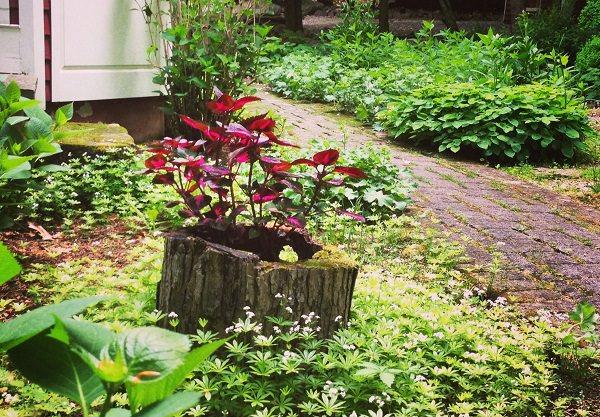
You can create a fabulous planter out of a tree stump. Plants you grow in it may not necessarily be flowering and colorful ones. It can be a climbing plant, creating a great frame around the stump or even moss, if it is in a shade you can choose interesting foliage plants that thrive in less sunlight.

Pick plants that are suitable to the style of your garden. It can either be a few blooming or grassy species. Petunias, nasturtiums, pansies or whatever you like.

Ferns, a variety of wildflowers, cornflower, marigolds, phlox, there are so many options. You can grow other plants around it. This tree stump planter will not go unnoticed and become one of the most beautiful focal points of your garden.
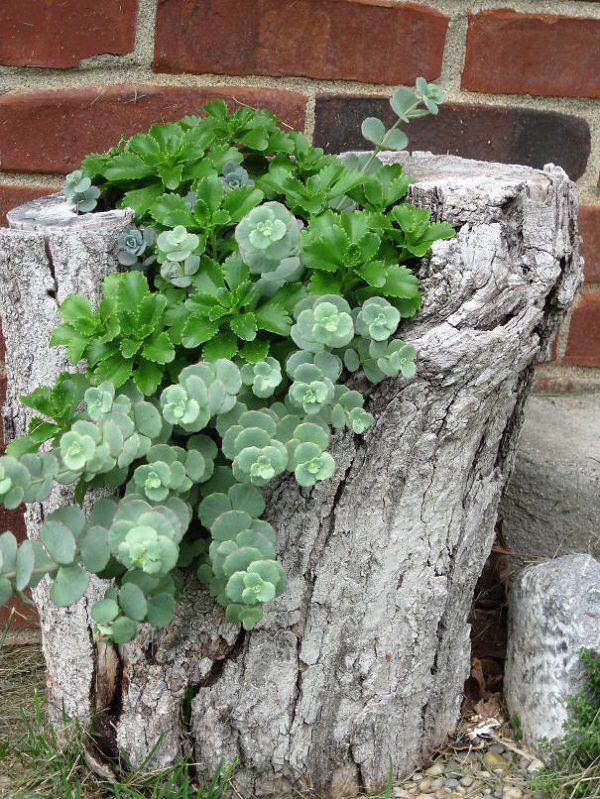
Whatever plant you choose to grow in your tree stump planter but remember, shallow root plants are most successful in it.
Tree Stump Planter Ideas#1. Tree Stump Planter

#2. Tree Stump Planter
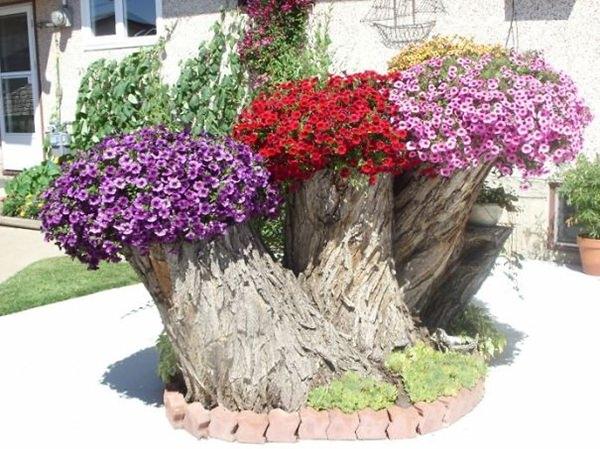
#3. Tree Stump Planter

#4. Tree Stump Planter
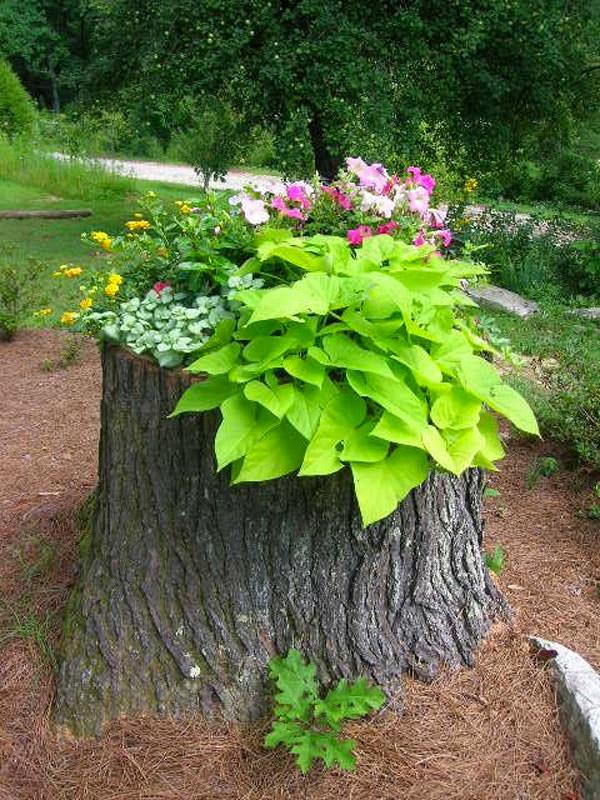
#5. Tree Stump Planter

#6. Tree Stump Planter

#7. Tree Stump Planter

#8. Tree Stump Planter

#9. Tree Stump Planter
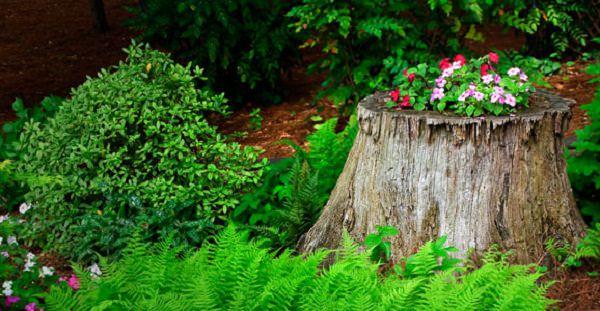
#10. Tree Stump Planter

#11. Tree Stump Planter

#12. Tree Stump Planter
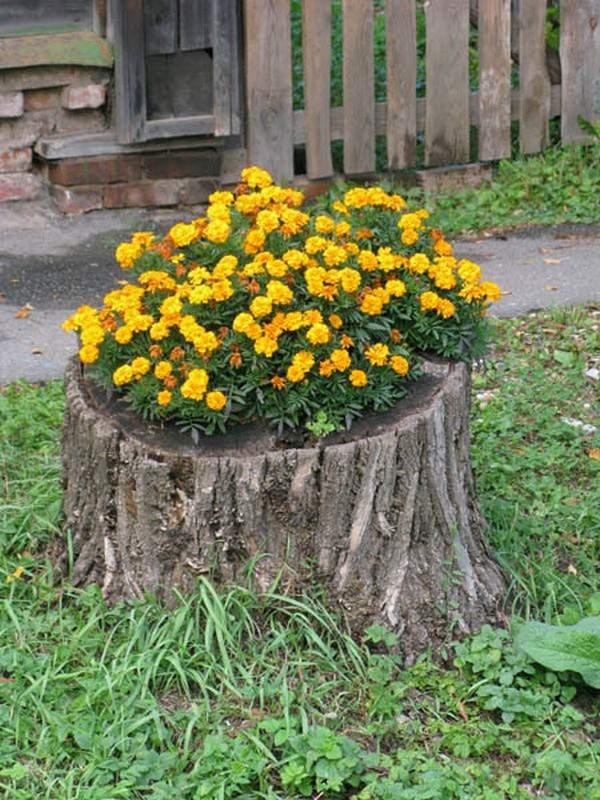
#13. Tree Stump Planter

#14. Tree Stump Planter
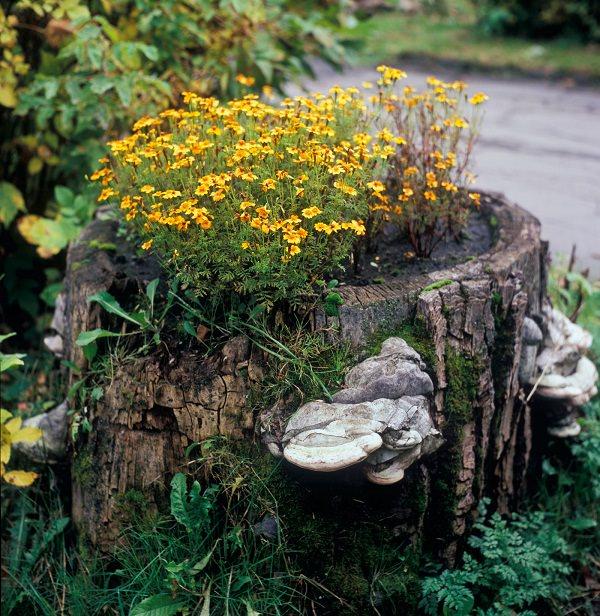
#15. Tree Stump Planter
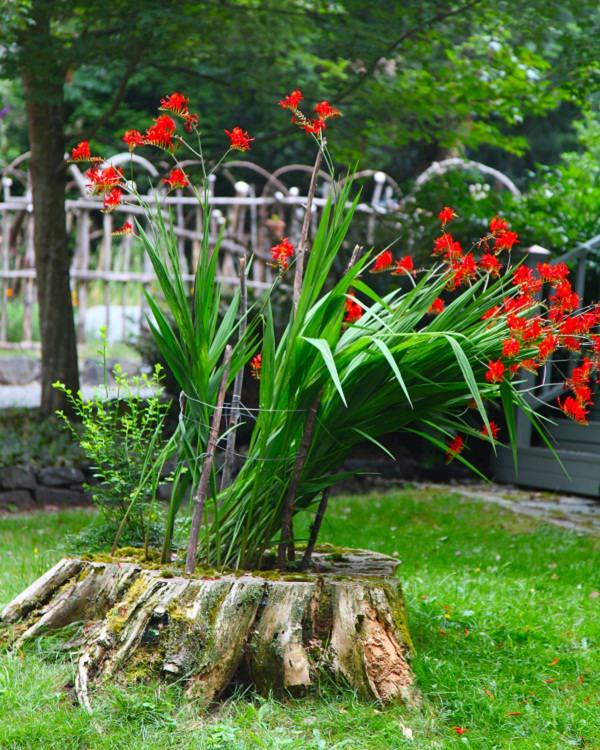
#16. Tree Stump Planter

#17. Tree Stump Planter

#18. Tree Stump Planter
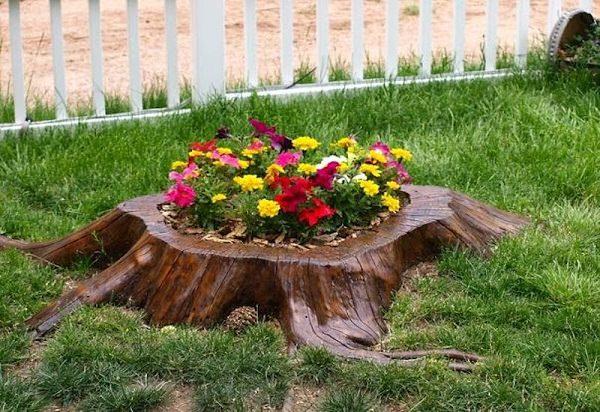
#19. Tree Stump Planter
Often the gardeners face a common problem– what to do with the saw cut stumps of old or diseased trees. Uprooting them is a laborious task and also not cheap.
In such a case, landscapers offer a variety of solutions. But you can solve it on your own by turning a stump into a tree stump planter.
Also Read: How to Make a Tree Stump Planter
Here in this post, you’ll find 19 blazing tree stump planter ideas that’ll entice you to have one in your gardenPlants for a Tree Stump Planter


You can create a fabulous planter out of a tree stump. Plants you grow in it may not necessarily be flowering and colorful ones. It can be a climbing plant, creating a great frame around the stump or even moss, if it is in a shade you can choose interesting foliage plants that thrive in less sunlight.

Pick plants that are suitable to the style of your garden. It can either be a few blooming or grassy species. Petunias, nasturtiums, pansies or whatever you like.

Ferns, a variety of wildflowers, cornflower, marigolds, phlox, there are so many options. You can grow other plants around it. This tree stump planter will not go unnoticed and become one of the most beautiful focal points of your garden.

Whatever plant you choose to grow in your tree stump planter but remember, shallow root plants are most successful in it.
Tree Stump Planter Ideas#1. Tree Stump Planter

#2. Tree Stump Planter

#3. Tree Stump Planter

#4. Tree Stump Planter

#5. Tree Stump Planter

#6. Tree Stump Planter

#7. Tree Stump Planter

#8. Tree Stump Planter

#9. Tree Stump Planter

#10. Tree Stump Planter

#11. Tree Stump Planter

#12. Tree Stump Planter

#13. Tree Stump Planter

#14. Tree Stump Planter

#15. Tree Stump Planter

#16. Tree Stump Planter

#17. Tree Stump Planter

#18. Tree Stump Planter

#19. Tree Stump Planter
0
0
文章
stone
2017年05月22日
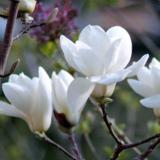
#彩色马蹄莲 与#白色马蹄莲 在栽培管理上没有太大的区别。生长适温均为15℃至25℃,开花期间,日间温度为16℃至19℃,白色品种夜间温度不低于13℃,而有色品种应不低于16℃。若温度高于25℃或低于5℃,则植株被迫进入休眠。它性喜温暖湿润和阳光充足的环境,不耐寒冷和干旱。
彩色马蹄莲植株开完花后,浇水量要逐渐减少,叶变黄枯萎时,要完全停止浇水。生长季节,每半月施稀薄液肥一次,当花莛抽出后,要增加到每周一次,直到花期结束为止。
家庭盆栽彩色马蹄莲,可施用多元缓释复合肥颗粒,也可用0.2%的尿素加0.1%的磷酸二氢钾混合液。栽培用土,可用园土、腐叶土、泥炭土按2∶2∶1 混合,再加入少量的多元复合肥颗粒。
家庭养护马蹄莲时,还应注意以下三点:一是它的心叶忌水湿,平时浇水不留心,使污水滴流入叶心内,易引起软腐病;二是施肥时要从盆缘施入,切忌肥液淋入叶柄内或溅入株心,否则易引起黄叶或腐烂;三是马蹄莲怕烟熏,否则会引起叶片发黄和花苞脱落。
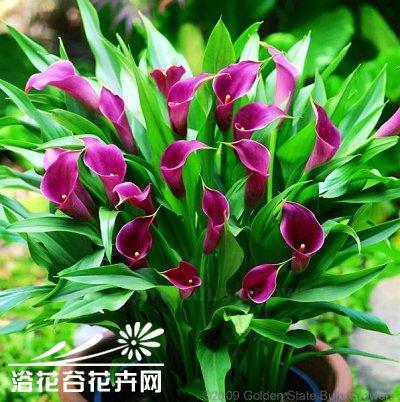
盆栽彩色马蹄莲的栽培技术如下:
上盆要领
预处理:种球到货后,可用赤霉素或勃宁激动素来增加开花数量,可用50-100ppm赤霉素或勃宁激动素浸泡5-10分钟,取出晒干,赤霉素的处理对花梗的长度影响不大,但会使叶片变得狭长,影响观赏价值;500ppm百菌清加500ppm瑞毒霉浸2分钟取出晒干,这一步骤对根茎腐病和软腐病的防治特别重要;在种植时生长点向上;覆土约5厘米后厚;种后淋透清水。
水分管理
块茎需要很多的水分,在生长早期要有规律的浇水,但不要让土太湿,等叶抽出来进入旺盛生长期时注意见干见湿。一般早上浇水,如果天气太热就需要在下午浇水。
使用滴灌能很好的保持水分,在有风的天气下更适于使用。如果要用喷雾灌溉的话,喷头的距离要精确,以保证水量的均匀分布。喷头必须比植株高1米,喷灌系统必须要有足够的压力(至少4千克压力)。植株在水分过多或过少时抗病性会降低,尤其对软腐病抗性会降低。
肥料管理
彩色马蹄莲属于需肥不高的花卉,不同的类型要求不同的肥料水平。用NPK比为20-20-20或12:10:10的均衡肥料,以100ppm的氮浓度每周施一次或200ppm的氮浓度每周施两次左右。
矮化处理
盆栽彩色马蹄莲品种通常高30-50厘米,可根据种植盆的规格和市场需求来决定是否进行矮化处理。嘧啶醇和多效唑对彩色马蹄莲是有效的,矮化处理对叶片的长度有明显的控制,但对花梗的抽长影响不太明显。
病虫害防治
在整个生长季节必须有详细的打药计划,主要用内吸杀虫剂。彩色马蹄莲的主要虫害是蓟马和蚜虫,控制它们特别重要,因为蚜虫能传播病毒。
出芽后就应该开始喷药,每7-10天喷一次,开花结束后,可每3周喷药一次。下面这些药比较适合用在彩色马蹄莲上:地亚农(二嗪磷)、敌杀死、马扑立克(氟胺氰菊脂)、乙酰甲胺磷和敌死通等粒状药(内吸杀菌剂)。这些药在潮湿条件下开始起作用,植株从根部吸收后向上传导,能防治蚜虫和蓟马。这些药品都是危险品,使用时要特别小心,选择多种农药混合使用或轮换使用可防止害虫产生抗药性。注意整个植株都必须喷上药。
种球病害控制
彩色马蹄莲容易被病霉菌和丝核菌从根部侵染,且只有在侵染两周后地上部分才会表现出来,表现为叶片发黄、萎蔫及卷曲等不良症状。如果在潮湿状态下,很容易发生细菌软腐病。在栽植后每2-4周使用根菌清和瑞毒霉,浓度为1升水用0.5克根菌清和0.5克瑞毒霉,灌根一次。
腐霉菌可用呋霜灵控制,但要确保对植株无害,在喷后一周内不要喷杀虫剂。病菌能通过灌溉及地面污染的水传染,要严格检查水源,如有污染要采取针对性处理。
花期病害控制
在湿度大或多雨的季节,花头上有病斑是很常见的。易感染的病害有灰霉病和交链孢萎蔫病。每7-10天喷一次保护性杀菌剂(如百菌清、克菌丹、福美双、代森锰锌和甲苯氟磺胺等)以确保花上有药物残留。
当病害较为严重时,要及时喷治疗性杀菌剂(要能耐小雨,并能在晚上较冷时使用)。这种杀菌剂包括根菌清、异菌脲、咪鲜胺施保克。但一种要每一季只能用2-3次,在湿季下雨前2-3天及时喷药。除了在花期,每10天喷一次可杀得(氢氧化铜)能起到很好的保护效果(100克/100升)。
细菌性软腐病在彩色马蹄莲上是特别严重的问题。好的种球管理将有助于控制细菌性软腐病的发生,尤其是在起球及贮存时应特别注意。当土壤温度高于23℃时植株易感染病菌。
在生长阶段内,当植株抗性减弱时易感染软腐病。许多因素将导致植株抗性减弱,如最初的病原菌侵染、过湿或太干、药害及肥烧、过高的土壤盐分、芽前除草剂的伤害、过高的土壤温度或不适的气候条件。一旦染上细菌性软腐病,病菌将很难根除,可用有保护性的“BTAPO”浇灌,并定期叶面喷洒可杀得(氢氧化铜)。研究表明,抗性弱及细菌性软腐病是彩色马蹄莲栽培上的主要两个问题。细菌性软腐病在高湿、高温条件下极易发生,现在有许多实践经验可用来避免这些问题的发生:
使用排水良好、含氧量高的栽培土壤或基质,因为细菌性软腐病为兼气性厌氧性细菌;
种植密度不要太疏,以利用叶子遮荫,减低土壤温度;
保持土壤微酸性和块茎的高钙浓度,使用石膏可提高钙含量,但不提高pH值,避免人和动物伤害种球。
马蹄莲植株花谢后,应逐渐减少浇水量,至4月下旬搬至室外,放置在略有蔽荫处养护,每天浇水一次,并向花盆附近地面洒水,借以增加空气湿度。6月以后,叶片逐渐枯黄进入休眠期,这时要剪去枯叶,控制浇水,停止施肥,将花盆搬放到通风凉爽处,促使其休眠。至秋季天气转凉后再将块茎从花盆内倒出,取出大的块茎,用新鲜肥沃的培养土重新栽植,待块茎萌发出叶时,再逐渐增加浇水量,同时恢复施肥,便可使其继续开花。
彩色马蹄莲植株开完花后,浇水量要逐渐减少,叶变黄枯萎时,要完全停止浇水。生长季节,每半月施稀薄液肥一次,当花莛抽出后,要增加到每周一次,直到花期结束为止。
家庭盆栽彩色马蹄莲,可施用多元缓释复合肥颗粒,也可用0.2%的尿素加0.1%的磷酸二氢钾混合液。栽培用土,可用园土、腐叶土、泥炭土按2∶2∶1 混合,再加入少量的多元复合肥颗粒。
家庭养护马蹄莲时,还应注意以下三点:一是它的心叶忌水湿,平时浇水不留心,使污水滴流入叶心内,易引起软腐病;二是施肥时要从盆缘施入,切忌肥液淋入叶柄内或溅入株心,否则易引起黄叶或腐烂;三是马蹄莲怕烟熏,否则会引起叶片发黄和花苞脱落。

盆栽彩色马蹄莲的栽培技术如下:
上盆要领
预处理:种球到货后,可用赤霉素或勃宁激动素来增加开花数量,可用50-100ppm赤霉素或勃宁激动素浸泡5-10分钟,取出晒干,赤霉素的处理对花梗的长度影响不大,但会使叶片变得狭长,影响观赏价值;500ppm百菌清加500ppm瑞毒霉浸2分钟取出晒干,这一步骤对根茎腐病和软腐病的防治特别重要;在种植时生长点向上;覆土约5厘米后厚;种后淋透清水。
水分管理
块茎需要很多的水分,在生长早期要有规律的浇水,但不要让土太湿,等叶抽出来进入旺盛生长期时注意见干见湿。一般早上浇水,如果天气太热就需要在下午浇水。
使用滴灌能很好的保持水分,在有风的天气下更适于使用。如果要用喷雾灌溉的话,喷头的距离要精确,以保证水量的均匀分布。喷头必须比植株高1米,喷灌系统必须要有足够的压力(至少4千克压力)。植株在水分过多或过少时抗病性会降低,尤其对软腐病抗性会降低。
肥料管理
彩色马蹄莲属于需肥不高的花卉,不同的类型要求不同的肥料水平。用NPK比为20-20-20或12:10:10的均衡肥料,以100ppm的氮浓度每周施一次或200ppm的氮浓度每周施两次左右。
矮化处理
盆栽彩色马蹄莲品种通常高30-50厘米,可根据种植盆的规格和市场需求来决定是否进行矮化处理。嘧啶醇和多效唑对彩色马蹄莲是有效的,矮化处理对叶片的长度有明显的控制,但对花梗的抽长影响不太明显。
病虫害防治
在整个生长季节必须有详细的打药计划,主要用内吸杀虫剂。彩色马蹄莲的主要虫害是蓟马和蚜虫,控制它们特别重要,因为蚜虫能传播病毒。
出芽后就应该开始喷药,每7-10天喷一次,开花结束后,可每3周喷药一次。下面这些药比较适合用在彩色马蹄莲上:地亚农(二嗪磷)、敌杀死、马扑立克(氟胺氰菊脂)、乙酰甲胺磷和敌死通等粒状药(内吸杀菌剂)。这些药在潮湿条件下开始起作用,植株从根部吸收后向上传导,能防治蚜虫和蓟马。这些药品都是危险品,使用时要特别小心,选择多种农药混合使用或轮换使用可防止害虫产生抗药性。注意整个植株都必须喷上药。
种球病害控制
彩色马蹄莲容易被病霉菌和丝核菌从根部侵染,且只有在侵染两周后地上部分才会表现出来,表现为叶片发黄、萎蔫及卷曲等不良症状。如果在潮湿状态下,很容易发生细菌软腐病。在栽植后每2-4周使用根菌清和瑞毒霉,浓度为1升水用0.5克根菌清和0.5克瑞毒霉,灌根一次。
腐霉菌可用呋霜灵控制,但要确保对植株无害,在喷后一周内不要喷杀虫剂。病菌能通过灌溉及地面污染的水传染,要严格检查水源,如有污染要采取针对性处理。
花期病害控制
在湿度大或多雨的季节,花头上有病斑是很常见的。易感染的病害有灰霉病和交链孢萎蔫病。每7-10天喷一次保护性杀菌剂(如百菌清、克菌丹、福美双、代森锰锌和甲苯氟磺胺等)以确保花上有药物残留。
当病害较为严重时,要及时喷治疗性杀菌剂(要能耐小雨,并能在晚上较冷时使用)。这种杀菌剂包括根菌清、异菌脲、咪鲜胺施保克。但一种要每一季只能用2-3次,在湿季下雨前2-3天及时喷药。除了在花期,每10天喷一次可杀得(氢氧化铜)能起到很好的保护效果(100克/100升)。
细菌性软腐病在彩色马蹄莲上是特别严重的问题。好的种球管理将有助于控制细菌性软腐病的发生,尤其是在起球及贮存时应特别注意。当土壤温度高于23℃时植株易感染病菌。
在生长阶段内,当植株抗性减弱时易感染软腐病。许多因素将导致植株抗性减弱,如最初的病原菌侵染、过湿或太干、药害及肥烧、过高的土壤盐分、芽前除草剂的伤害、过高的土壤温度或不适的气候条件。一旦染上细菌性软腐病,病菌将很难根除,可用有保护性的“BTAPO”浇灌,并定期叶面喷洒可杀得(氢氧化铜)。研究表明,抗性弱及细菌性软腐病是彩色马蹄莲栽培上的主要两个问题。细菌性软腐病在高湿、高温条件下极易发生,现在有许多实践经验可用来避免这些问题的发生:
使用排水良好、含氧量高的栽培土壤或基质,因为细菌性软腐病为兼气性厌氧性细菌;
种植密度不要太疏,以利用叶子遮荫,减低土壤温度;
保持土壤微酸性和块茎的高钙浓度,使用石膏可提高钙含量,但不提高pH值,避免人和动物伤害种球。
马蹄莲植株花谢后,应逐渐减少浇水量,至4月下旬搬至室外,放置在略有蔽荫处养护,每天浇水一次,并向花盆附近地面洒水,借以增加空气湿度。6月以后,叶片逐渐枯黄进入休眠期,这时要剪去枯叶,控制浇水,停止施肥,将花盆搬放到通风凉爽处,促使其休眠。至秋季天气转凉后再将块茎从花盆内倒出,取出大的块茎,用新鲜肥沃的培养土重新栽植,待块茎萌发出叶时,再逐渐增加浇水量,同时恢复施肥,便可使其继续开花。
0
1
文章
Andy
2017年05月22日

See these 19 tea herbs to make a tea herb garden. It is a wonderful accent that can go along with the rest of your garden and brings you the joy of fresh herbs, you can use these herbs to prepare aromatic, healthy and tasty herbal teas of different flavors.
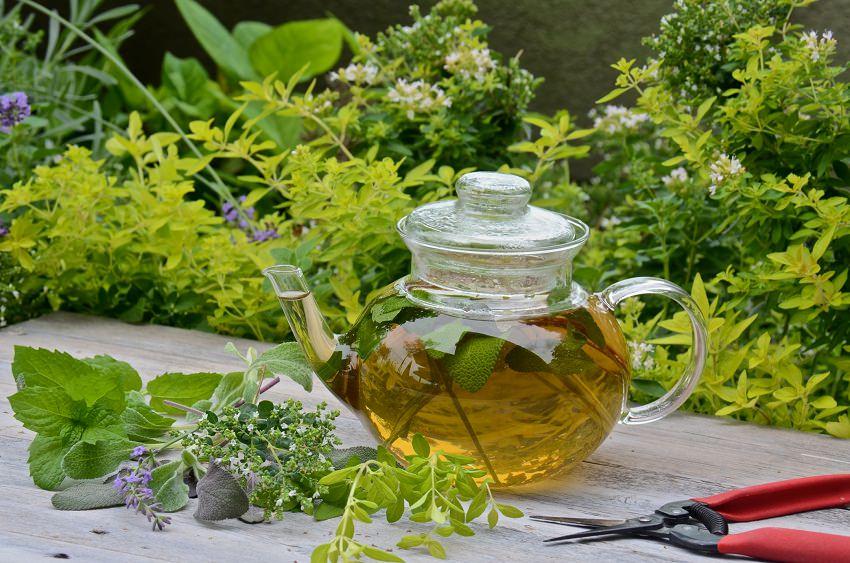
1. Lavender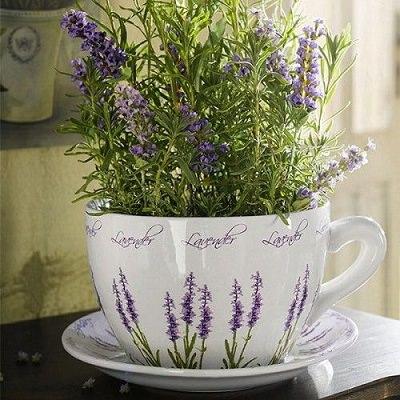
Maybe you’ve never thought to make lavender tea but its floral taste is amazing. A delicious cup of herbal tea you can make from lavender flowers that is sweet and fragrant in taste and is perfect for calming your mind, particularly recommended to reduce tension and alleviate headache.
Lavender grows well in full sun, in well drained soil.
Also read : How to Grow Lavender Plants
2. Lemon Verbena
Lemon verbena leaves are used to make tea. Consumption of its tea improves digestion, joint pain and helps in asthma.
Refreshing and sour, this lemon flavored plant is easy to grow. It needs full sun to thrive and doesn’t tolerate severe winters. Below 14 F (-10 C) the plant dies. It’s more suitable for subtropical and tropical climate, although you can grow lemon verbena in cold climate, but in containers.
3. Mint
Mint is a most favorite tea herb and popular among herbal tea lovers, it’s also one of the easiest plants to grow. Mint tea fights with digestive disorders, abdominal pain and stomach cramps. Besides this, it stimulates the appetite, reduces flatulence and is very refreshing in flavor.
Mint is very robust plant and can even get out of hand in the garden if you don’t care to stop it. It grows in moist soil in full to partial sun.
Also read: How to Control Invasive Plants
4. Lemon Balm
Lemon balm plant is closely related to mint, but has a distinct lemon flavor. It gives flavor to herbal teas and ice creams and appears to be a useful fragrant herb in the kitchens.
Lemon balm grows well in dry soil and partial shade. If grown outside it dies in winter but regrow again in spring. Lemon balm spreads vigorously if grown in garden beds so it’s better to grow it in a confined space or in a container.
5. Ginger
Ginger tea is popular, especially in South and East Asia. Its roots and leaves can be used to make tea. Use of ginger tea is praised in ancient Chinese medicines and Ayurveda, it’s an antioxidant and contains antibacterial properties. It cures diseases like cold, flu, nausea and improves digestion and appetite.
Ginger is such an easy to grow and forget it plant that you’ll definitely like to grow. It is hardy in USDA zones 9 – 12 and grows best in filtered sunlight and moist soil in a spot that is less windy.
6. Thyme
Thyme is an effective herbal tea ingredient that calms stomach problems and sore throat. Use its leaves to prepare tea, if there are flowers, add them too.
Thyme grows well in full sun but also tolerate partial sun and is an ideal herb that is very low maintenance.
7. Chamomile
Beautiful daisy like flowers that smells mildly fruity like an apple, chamomile is a useful medicinal tea herb. It’s traditionally used to induce calm and sleep. You can prepare its tea with small white and yellow flowers rather than the leaves. There are two kinds of chamomile (German and Roman), Roman chamomile offers strong flavored tea.
Chamomile likes sandy soil and lots of sun and it needs a lot of water during the summer. It’s hardy under USDA Zones 4 – 9.
8. Jasmine
Jasmine flowers are suitable to make tea, for this you need to pick some fresh flowers. Dry and mix them with green tea, you can also steep them alone to make jasmine tea.
Jasmine vine thrives in full sun and needs a trellis or a support to climb. It’s not suitable for harsh winter climates, so if you want to grow it, grow it in container that can be moved inside.
9. Stevia
Stevia leaves are sweet and can be steeped to make tea. It’s a safe and natural sweetener, used in place of sugar in an infusion and good for diabetics.
Stevia grows in USDA Zones 9 to 11, it doesn’t tolerate cold. Still, you can grow it in more colder zones in a pot so that it can be brought inside when winter comes.
10. Marjoram
This culinary herb has a fruity and sour flavor with a hint of mint. Marjoram tea cures various digestion and stomach problems including poor appetite, liver disease, gallstones, intestinal gas, and stomach cramps.
It grows well in full sun but can tolerate light shade, it needs loose and well drained soil.
11. Cilantro
Commonly used for cooking, cilantro is also suitable for tea. Its tea resembles aroma similar to Lady Gray tea. Mix honey in it to soothe the acidity and constipation. It also clears toxins from the body and prevents indigestion.
It grows in both the sun and partial shade and is an ideal herb for pots. Cilantro grows diversely as annual herb in almost any climate, it can be grown under USDA Zones 3 – 11.
12. Rosemary
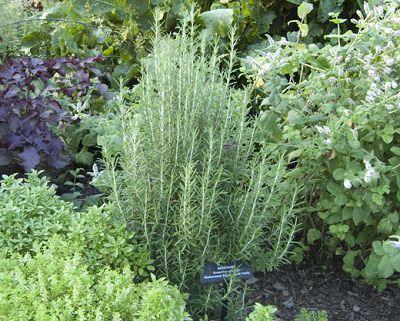
Rosemary tea improves digestion, promotes cognitive function and acts as an antioxidant, protecting the body from heart disease and cancer.
Rosemary plant prefers full sun, light and well drained soil.
13. Fennel
Fennel seeds are used to prepare its tea. Fennel tea is very beneficial for digestive disorders like irritable bowel syndrome, bloating and flatulence.
Fennel grows in USDA zones 4 to 10 in moist and fertile soil in full to partial sun.
14. St. John’s wort
It is a very effective remedy against nervous disorders: insomnia, depression, anxiety etc. However, it also has some side effects.
It grows very easily without special care. It can be grown on the ground or in pots.
To learn how to grow St John’s wort read this.
15. Sage
The antiseptic tonic of sage enables to provide an effective remedy for ailments as varied as: mouth ulcer and sore throat. Sage tea also helps in depression and Alzheimer. Take 1 tablespoon fresh sage leaves and 1 tablespoon dried sage leaves and steep it for 3 – 5 minutes in boiling water. Strain it and mix honey in it for taste. Your sage tea is ready.
It can be grown either in the ground or in pots. If grown in pots it’s important to water sage regularly.
16. Viola tricolor
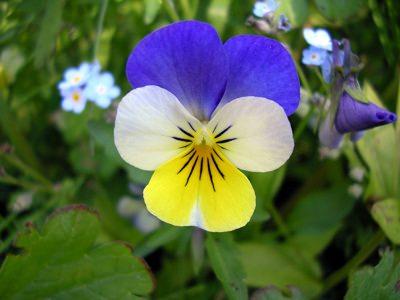
Often referred as wild pansy, it’s a common European flower that grows wild as a short lived perennial. Viola tricolor is known for its medicinal properties. It contains flavonoids, saponins, anthocyanins, carotenoids that helps in fighting myriads of human diseases like cancer, various skin diseases, allergies and sore throat. You can use whole plant to make tea.
Also called as heartsease, viola tricolor grows in partial shade in slightly acidic to neutral soil. It’s hardy in USDA zones 3 to 9
17. Basil
Basil especially holy basil or ‘tulsi’ is best to make basil tea, you can also add honey and ginger in it. Other varieties of basil are also used. Basil is stress reliever and if used with honey and ginger it helps in asthma and cough, cold and influenza. Consumption of basil tea lowers the blood sugar level and helps in heart diseases. Basil tea is also a good cure of mouth problems and bad breath.
Holy Basil loves warm exhibition, it’s a tropical plant, hardy in USDA Zones 10, 11 and grows best when temperature stays around 70 – 86 F (20 – 30 C).
18. Catnip
Mildly sedative and calming, catnip tea is excellent treat after an exhausting day. It helps in digestive disorder like diarrhea, relieves headache and insomnia and if you’re going through nicotine withdrawal, it alleviates the stress. Both the leaves and flowers are used to prepare tea.
If you know how to save your catnip plant from cats for your use growing it is easy. It’s hardy in USDA Zones 3 – 8 and prefers well drained soil that is sandy, although catnip grows in variety of soil types. Keep your plant in full to partial sun.
19. Lemon Grass
Lemon grass (Cymbopogon citratus) is used to make herbal tea, in soups and other dishes. This lemony scented tea herb also repels pests like white flies away from garden.
Grow lemongrass in warm and sunny spot and do regular watering. Lemongrass is hardy in USDA Zones 9 – 11, however if you like to grow it in colder climate you can grow it in a pot and bring that indoors or in a greenhouse in winter.

1. Lavender

Maybe you’ve never thought to make lavender tea but its floral taste is amazing. A delicious cup of herbal tea you can make from lavender flowers that is sweet and fragrant in taste and is perfect for calming your mind, particularly recommended to reduce tension and alleviate headache.
Lavender grows well in full sun, in well drained soil.
Also read : How to Grow Lavender Plants
2. Lemon Verbena
Lemon verbena leaves are used to make tea. Consumption of its tea improves digestion, joint pain and helps in asthma.
Refreshing and sour, this lemon flavored plant is easy to grow. It needs full sun to thrive and doesn’t tolerate severe winters. Below 14 F (-10 C) the plant dies. It’s more suitable for subtropical and tropical climate, although you can grow lemon verbena in cold climate, but in containers.
3. Mint
Mint is a most favorite tea herb and popular among herbal tea lovers, it’s also one of the easiest plants to grow. Mint tea fights with digestive disorders, abdominal pain and stomach cramps. Besides this, it stimulates the appetite, reduces flatulence and is very refreshing in flavor.
Mint is very robust plant and can even get out of hand in the garden if you don’t care to stop it. It grows in moist soil in full to partial sun.
Also read: How to Control Invasive Plants
4. Lemon Balm
Lemon balm plant is closely related to mint, but has a distinct lemon flavor. It gives flavor to herbal teas and ice creams and appears to be a useful fragrant herb in the kitchens.
Lemon balm grows well in dry soil and partial shade. If grown outside it dies in winter but regrow again in spring. Lemon balm spreads vigorously if grown in garden beds so it’s better to grow it in a confined space or in a container.
5. Ginger
Ginger tea is popular, especially in South and East Asia. Its roots and leaves can be used to make tea. Use of ginger tea is praised in ancient Chinese medicines and Ayurveda, it’s an antioxidant and contains antibacterial properties. It cures diseases like cold, flu, nausea and improves digestion and appetite.
Ginger is such an easy to grow and forget it plant that you’ll definitely like to grow. It is hardy in USDA zones 9 – 12 and grows best in filtered sunlight and moist soil in a spot that is less windy.
6. Thyme
Thyme is an effective herbal tea ingredient that calms stomach problems and sore throat. Use its leaves to prepare tea, if there are flowers, add them too.
Thyme grows well in full sun but also tolerate partial sun and is an ideal herb that is very low maintenance.
7. Chamomile
Beautiful daisy like flowers that smells mildly fruity like an apple, chamomile is a useful medicinal tea herb. It’s traditionally used to induce calm and sleep. You can prepare its tea with small white and yellow flowers rather than the leaves. There are two kinds of chamomile (German and Roman), Roman chamomile offers strong flavored tea.
Chamomile likes sandy soil and lots of sun and it needs a lot of water during the summer. It’s hardy under USDA Zones 4 – 9.
8. Jasmine
Jasmine flowers are suitable to make tea, for this you need to pick some fresh flowers. Dry and mix them with green tea, you can also steep them alone to make jasmine tea.
Jasmine vine thrives in full sun and needs a trellis or a support to climb. It’s not suitable for harsh winter climates, so if you want to grow it, grow it in container that can be moved inside.
9. Stevia
Stevia leaves are sweet and can be steeped to make tea. It’s a safe and natural sweetener, used in place of sugar in an infusion and good for diabetics.
Stevia grows in USDA Zones 9 to 11, it doesn’t tolerate cold. Still, you can grow it in more colder zones in a pot so that it can be brought inside when winter comes.
10. Marjoram
This culinary herb has a fruity and sour flavor with a hint of mint. Marjoram tea cures various digestion and stomach problems including poor appetite, liver disease, gallstones, intestinal gas, and stomach cramps.
It grows well in full sun but can tolerate light shade, it needs loose and well drained soil.
11. Cilantro
Commonly used for cooking, cilantro is also suitable for tea. Its tea resembles aroma similar to Lady Gray tea. Mix honey in it to soothe the acidity and constipation. It also clears toxins from the body and prevents indigestion.
It grows in both the sun and partial shade and is an ideal herb for pots. Cilantro grows diversely as annual herb in almost any climate, it can be grown under USDA Zones 3 – 11.
12. Rosemary

Rosemary tea improves digestion, promotes cognitive function and acts as an antioxidant, protecting the body from heart disease and cancer.
Rosemary plant prefers full sun, light and well drained soil.
13. Fennel
Fennel seeds are used to prepare its tea. Fennel tea is very beneficial for digestive disorders like irritable bowel syndrome, bloating and flatulence.
Fennel grows in USDA zones 4 to 10 in moist and fertile soil in full to partial sun.
14. St. John’s wort
It is a very effective remedy against nervous disorders: insomnia, depression, anxiety etc. However, it also has some side effects.
It grows very easily without special care. It can be grown on the ground or in pots.
To learn how to grow St John’s wort read this.
15. Sage
The antiseptic tonic of sage enables to provide an effective remedy for ailments as varied as: mouth ulcer and sore throat. Sage tea also helps in depression and Alzheimer. Take 1 tablespoon fresh sage leaves and 1 tablespoon dried sage leaves and steep it for 3 – 5 minutes in boiling water. Strain it and mix honey in it for taste. Your sage tea is ready.
It can be grown either in the ground or in pots. If grown in pots it’s important to water sage regularly.
16. Viola tricolor

Often referred as wild pansy, it’s a common European flower that grows wild as a short lived perennial. Viola tricolor is known for its medicinal properties. It contains flavonoids, saponins, anthocyanins, carotenoids that helps in fighting myriads of human diseases like cancer, various skin diseases, allergies and sore throat. You can use whole plant to make tea.
Also called as heartsease, viola tricolor grows in partial shade in slightly acidic to neutral soil. It’s hardy in USDA zones 3 to 9
17. Basil
Basil especially holy basil or ‘tulsi’ is best to make basil tea, you can also add honey and ginger in it. Other varieties of basil are also used. Basil is stress reliever and if used with honey and ginger it helps in asthma and cough, cold and influenza. Consumption of basil tea lowers the blood sugar level and helps in heart diseases. Basil tea is also a good cure of mouth problems and bad breath.
Holy Basil loves warm exhibition, it’s a tropical plant, hardy in USDA Zones 10, 11 and grows best when temperature stays around 70 – 86 F (20 – 30 C).
18. Catnip
Mildly sedative and calming, catnip tea is excellent treat after an exhausting day. It helps in digestive disorder like diarrhea, relieves headache and insomnia and if you’re going through nicotine withdrawal, it alleviates the stress. Both the leaves and flowers are used to prepare tea.
If you know how to save your catnip plant from cats for your use growing it is easy. It’s hardy in USDA Zones 3 – 8 and prefers well drained soil that is sandy, although catnip grows in variety of soil types. Keep your plant in full to partial sun.
19. Lemon Grass
Lemon grass (Cymbopogon citratus) is used to make herbal tea, in soups and other dishes. This lemony scented tea herb also repels pests like white flies away from garden.
Grow lemongrass in warm and sunny spot and do regular watering. Lemongrass is hardy in USDA Zones 9 – 11, however if you like to grow it in colder climate you can grow it in a pot and bring that indoors or in a greenhouse in winter.
2
2
文章
Abigal
2017年05月22日

Checkout 19 best pergola plants for your garden. These climbing plants for pergolas and arbors can also be grown in small gardens easily.

There are so many climbing plants that can be guided over a pergola to get a welcome shade in warm weather. For your help, here we have listed 19 best pergola plants. This list is a combination of both tropical and temperate vines.
Best Pergola PlantsRose

Roses are classic. They are the favorite plants of most gardeners as they produce a feeling of being special, tranquility, nostalgia, romance, and happiness. Climbing varieties are perfect to cover a pergola and arches.
Clematis

Surely, one of the best pergola plants. Clematis is a spectacular vine as it blooms abundantly, flowering usually starts from spring. You can grow it easily and combine with other plants, especially with climbing roses to get a more exquisite view.
Honeysuckle

The fragrance of honeysuckle flowers is nostalgic and multiplies when dusk sets. It has more than 180 different species, almost all are creepers. It is a very large vine that grows rapidly, a single honeysuckle plant can cover up a big sturdy pergola easily.
Passion Flower (Passiflora)

Passion flower is a beautiful fast growing, hardy perennial in tropics. The heady fragrance, colorful flowers, and edible fruits make it one of most desirable climbing plant you can have in your garden. You can also grow it on your balcony, rooftop or patio garden. Growing passion flower is easy if you live in the subtropical or tropical climate (USDA Zone 8 – 11). If you live in the temperate region then look for its cold hardy cultivars. In very cool climate you can grow it as annual.
Jasmine
 "1000084172_1000000025_1487218527.jpg">Surely, jasmine is the most intense flower. Its fragrance can be smelt from far-far away. So if you love fragrant plants, grow it. In warm and humid climates jasmine blooms year round. In cooler zones, grow it as annual.
"1000084172_1000000025_1487218527.jpg">Surely, jasmine is the most intense flower. Its fragrance can be smelt from far-far away. So if you love fragrant plants, grow it. In warm and humid climates jasmine blooms year round. In cooler zones, grow it as annual.
Grape Vine

Truly one of the best climbing plants for pergolas, grape vine will not only give shade and a warm sitting place but juicy grapefruits too. You can grow this in a variety of climates. Grapevine varieties are native to Mediterranean, Central Asia, America and South West Asia, thus cultivars available diversely. Here’s an interesting article on training grapevine on arbor, which you can read.
Wisteria

Lavender blue color of wisteria flowers and the sweet fragrance is fascinating. However, wisteria is an aggressive grower but it takes the time to establish. You can grow wisteria in temperate and subtropical regions (USDA Zones 4 – 9). If you have a large sturdy pergola grow wisteria on it, you’ll need to prune regularly to control its growth.
Trumpet Vine (Campsis radicans)

Due to its showy trumpet-shaped flowers, it is called trumpet vine. Each of trumpet vine flowers can appear in different colors (orange, yellow or red). The flowers attract pollinators: bees, and hummingbirds. This plant looks great on the arches, pergolas, and trellises. It grows best in full sun to part sun.
Bignonia (Cross Vine)

Another beautiful climber, related to trumpet vine. Its delicate bell-shaped flowers look great on pergolas. It is a fairly vigorous plant and tolerates mild to moderate frost, grows best in USDA Zones (6 – 9). You can also try growing it in tropics (Zone 10) in shade from afternoon sun.
Ivy

For the arbors, pergolas, and gazebos situated in shade, ivy is best. It is low maintenance and tolerates the exploits of weather and provides lush green color. You can also choose variegated varieties.
Bougainvillea

The climbing varieties of bougainvillea are suitable for the pergolas. This plant loves the sunny position and does not like wet feet. Among the most frequently cultivated colors are pink, red, yellow and purple but it comes in many other colors too.
Morning glory

A vine that greets the morning sun with its pretty blooms. Morning glory vine is fairly easy to grow and it perks up quickly. A good plant to cover up a pergola that is in a sunny position.
Kiwi

A kiwi vine takes a lot of space to grow that is why it is one of the best pergola plants in our list. In order to get fruits from the kiwi plant, you’ll need to have both male and female plants for pollination.
Sweet pea

Don’t grow bush type varieties if you are growing it over the pergola. Plant sweet peas in the sun and in a well-drained soil. Grow sweet peas in warm zones in fall and winter. In temperates plant this fragrant vine in spring or summer.
Bleeding heart

If you’re searching for a climber for shade, bleeding heart is one. Its beautiful heart shaped flowers looks exotic. This plant requires moist soil and a location that receives partial sun. Bleeding heart is suitable for cold temperate climates and can be grown in USDA Zones 3 – 9.
Tropical Bleeding Heart (Glory Bower)

Exquisite flowers and dark glossy foliage. The tropical bleeding heart vine is native to Western Africa, its flowers resemble the bleeding heart (Dicentra spectabilis), see above. Both have different requirements and tropical bleeding heart thrives well in heat and warmth (USDA Zones 10 – 11). *You can also grow it as a houseplant.
Butterfly Pea

Butterfly pea flowers are the best food source for butterflies. It is a legume and both flowers and seed pods are edible. The most attractive thing about butterfly pea vine is its shiny deep blue flowers. Butterfly pea is a tropical vine and grows best in USDA Zones 10 and 11. In a cold temperate zone, grow this perennial as annual.
Golden Hops

A fast growing vine that quickly covers up the trellises, pergolas, and arches. Golden hops can grow up to 8 m long without any difficulty. What makes it beautiful is its lime green or yellowish foliage. It is a low maintenance cold hardy vine (USDA Zones 4 – 8), not suitable for warm climates.
Climbing Hydrangea

Growing climbing hydrangea vine is rewarding due to its glossy heart-shaped foliage and fragrant white flowers that appear in clusters in spring to summer. It is a slow grower and requires training and pruning. You can grow climbing hydrangea if you live in the colder region within USDA Zones 5 – 8.

There are so many climbing plants that can be guided over a pergola to get a welcome shade in warm weather. For your help, here we have listed 19 best pergola plants. This list is a combination of both tropical and temperate vines.
Best Pergola PlantsRose

Roses are classic. They are the favorite plants of most gardeners as they produce a feeling of being special, tranquility, nostalgia, romance, and happiness. Climbing varieties are perfect to cover a pergola and arches.
Clematis

Surely, one of the best pergola plants. Clematis is a spectacular vine as it blooms abundantly, flowering usually starts from spring. You can grow it easily and combine with other plants, especially with climbing roses to get a more exquisite view.
Honeysuckle

The fragrance of honeysuckle flowers is nostalgic and multiplies when dusk sets. It has more than 180 different species, almost all are creepers. It is a very large vine that grows rapidly, a single honeysuckle plant can cover up a big sturdy pergola easily.
Passion Flower (Passiflora)

Passion flower is a beautiful fast growing, hardy perennial in tropics. The heady fragrance, colorful flowers, and edible fruits make it one of most desirable climbing plant you can have in your garden. You can also grow it on your balcony, rooftop or patio garden. Growing passion flower is easy if you live in the subtropical or tropical climate (USDA Zone 8 – 11). If you live in the temperate region then look for its cold hardy cultivars. In very cool climate you can grow it as annual.
Jasmine
Grape Vine

Truly one of the best climbing plants for pergolas, grape vine will not only give shade and a warm sitting place but juicy grapefruits too. You can grow this in a variety of climates. Grapevine varieties are native to Mediterranean, Central Asia, America and South West Asia, thus cultivars available diversely. Here’s an interesting article on training grapevine on arbor, which you can read.
Wisteria

Lavender blue color of wisteria flowers and the sweet fragrance is fascinating. However, wisteria is an aggressive grower but it takes the time to establish. You can grow wisteria in temperate and subtropical regions (USDA Zones 4 – 9). If you have a large sturdy pergola grow wisteria on it, you’ll need to prune regularly to control its growth.
Trumpet Vine (Campsis radicans)

Due to its showy trumpet-shaped flowers, it is called trumpet vine. Each of trumpet vine flowers can appear in different colors (orange, yellow or red). The flowers attract pollinators: bees, and hummingbirds. This plant looks great on the arches, pergolas, and trellises. It grows best in full sun to part sun.
Bignonia (Cross Vine)

Another beautiful climber, related to trumpet vine. Its delicate bell-shaped flowers look great on pergolas. It is a fairly vigorous plant and tolerates mild to moderate frost, grows best in USDA Zones (6 – 9). You can also try growing it in tropics (Zone 10) in shade from afternoon sun.
Ivy

For the arbors, pergolas, and gazebos situated in shade, ivy is best. It is low maintenance and tolerates the exploits of weather and provides lush green color. You can also choose variegated varieties.
Bougainvillea

The climbing varieties of bougainvillea are suitable for the pergolas. This plant loves the sunny position and does not like wet feet. Among the most frequently cultivated colors are pink, red, yellow and purple but it comes in many other colors too.
Morning glory

A vine that greets the morning sun with its pretty blooms. Morning glory vine is fairly easy to grow and it perks up quickly. A good plant to cover up a pergola that is in a sunny position.
Kiwi

A kiwi vine takes a lot of space to grow that is why it is one of the best pergola plants in our list. In order to get fruits from the kiwi plant, you’ll need to have both male and female plants for pollination.
Sweet pea

Don’t grow bush type varieties if you are growing it over the pergola. Plant sweet peas in the sun and in a well-drained soil. Grow sweet peas in warm zones in fall and winter. In temperates plant this fragrant vine in spring or summer.
Bleeding heart

If you’re searching for a climber for shade, bleeding heart is one. Its beautiful heart shaped flowers looks exotic. This plant requires moist soil and a location that receives partial sun. Bleeding heart is suitable for cold temperate climates and can be grown in USDA Zones 3 – 9.
Tropical Bleeding Heart (Glory Bower)

Exquisite flowers and dark glossy foliage. The tropical bleeding heart vine is native to Western Africa, its flowers resemble the bleeding heart (Dicentra spectabilis), see above. Both have different requirements and tropical bleeding heart thrives well in heat and warmth (USDA Zones 10 – 11). *You can also grow it as a houseplant.
Butterfly Pea

Butterfly pea flowers are the best food source for butterflies. It is a legume and both flowers and seed pods are edible. The most attractive thing about butterfly pea vine is its shiny deep blue flowers. Butterfly pea is a tropical vine and grows best in USDA Zones 10 and 11. In a cold temperate zone, grow this perennial as annual.
Golden Hops

A fast growing vine that quickly covers up the trellises, pergolas, and arches. Golden hops can grow up to 8 m long without any difficulty. What makes it beautiful is its lime green or yellowish foliage. It is a low maintenance cold hardy vine (USDA Zones 4 – 8), not suitable for warm climates.
Climbing Hydrangea

Growing climbing hydrangea vine is rewarding due to its glossy heart-shaped foliage and fragrant white flowers that appear in clusters in spring to summer. It is a slow grower and requires training and pruning. You can grow climbing hydrangea if you live in the colder region within USDA Zones 5 – 8.
0
0
文章
绮丽
2017年05月19日


#仙人指 的养殖方法
温度
仙人指的适宜生长温度在19-32℃之间,冬季的适宜温度为7-13℃,同时可以耐1~2℃低温。夏季高温时节需要适当遮阳并注意通风。
光照
仙人指性略耐荫,最好将其置于半阴环境当中。喜阳光,全年都要给予适当的光照,否则枝茎会变细,开花少,花期短,观赏价值大大降低。夏季避免强光直射,做好遮荫工作。此外,仙人指是短光照植物,每天的光照时间需控制在10小时以内。
土壤
适宜生长在富含有机质及排水良好的土壤。在粘性土壤中生长不良,盆土中宜掺入20~30%的河砂。
施肥
不喜大肥,以磷钾肥为好,每两周施薄肥一次。
浇水
仙人指较耐旱,管理时盆土宜见干见湿,切忌浇水过多,否则容易导致根系腐烂。生长季节充分浇水。冬季低温休眠期,保持盆土干燥即可。

仙人指的注意事项
控制水分
冬季需要经过一个受冻而休眠的阶段,否则很难开花。受冻后需要保持干燥到即将开花,这期间都无需浇水。
进入春季后依旧不浇水,等到花蕾有黄豆大小就可开始浇透水,这样可以促进仙人指多花蕾,利于开花。
在仙人指开花后以及夏季高温状态下的休眠期间,要控制水分,同时防止雨淋,避免发生烂根。
翻盆和修剪
每2年进行1次翻盆,基质可用腐叶
土、泥炭土、砻糠灰等材料配制。春季结合翻盆进行修剪工作,疏去过密的枝条,并对留下的枝条进行缩剪。修剪后喷洒石硫合剂以减少春季病菌危害。
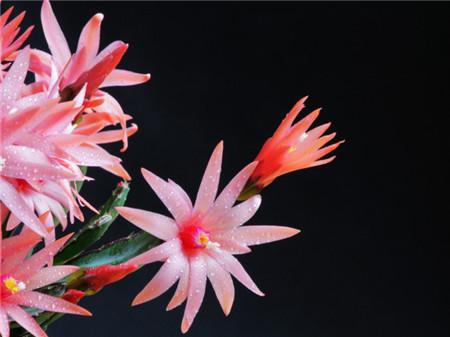
病虫害防治
预防为主,特别注意对蚧壳虫和茎腐病的防治。一般病害与虫害的药物可以混用,可以轮换使用多菌灵、甲基托布津等药物。
0
0



